Scovill Mfg. Co.
The Scovill &
Adams Co.
Acme Reversible Back View Camera
Variation 1
New Reversible Back Acme View Box
Reversible Back View Camera
Back Focus Cone View Camera
Acme View Camera
(W. D. Gatchel Catalog, 1888, p. 32)
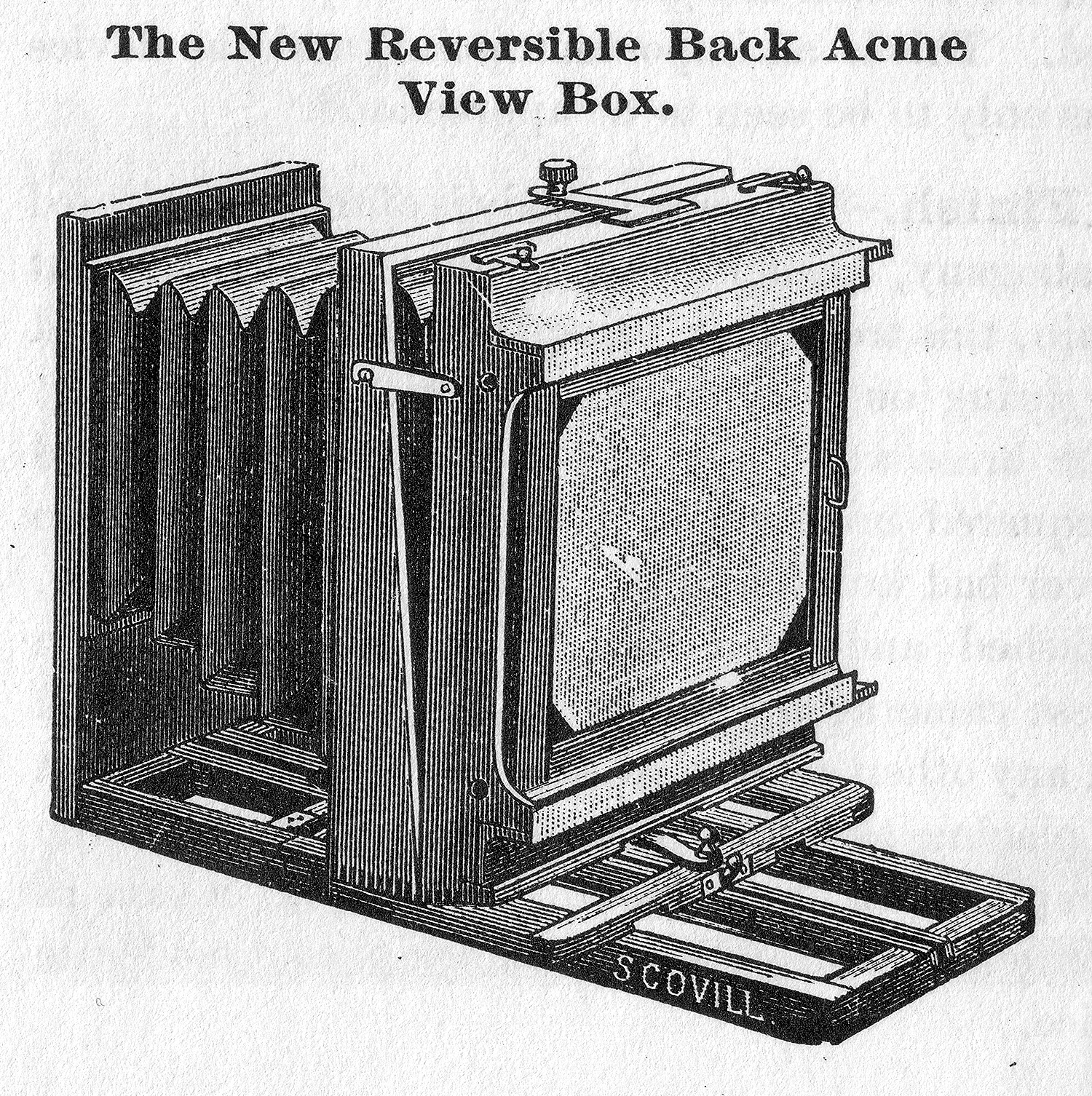
Scovill Mfg.
Co. 8 x 10",
single swing, No Label, Serial No. 50.
This camera is labeled "Scovill Mfg. Co. N.Y.", and therefore had to
have been made prior to the Scovill & Adams Co. in 1889. It was
probably made in Scovill factory in New Haven, CT, despite having all the hallmarks of an American Optical product - fine French polish finish for the wood, draw file
finish for the hardware, and screw slots aligned.
While the lens board appears to be original and the one purchased with
the camera, the round attachment bearing the lens is not - it is a
patch, filling a hole (probably for a different lens) that was too large
for this Waterbury lens.
Additionally, the case that fits this
camera so well is an E. & H.T. Anthony & Co. product.
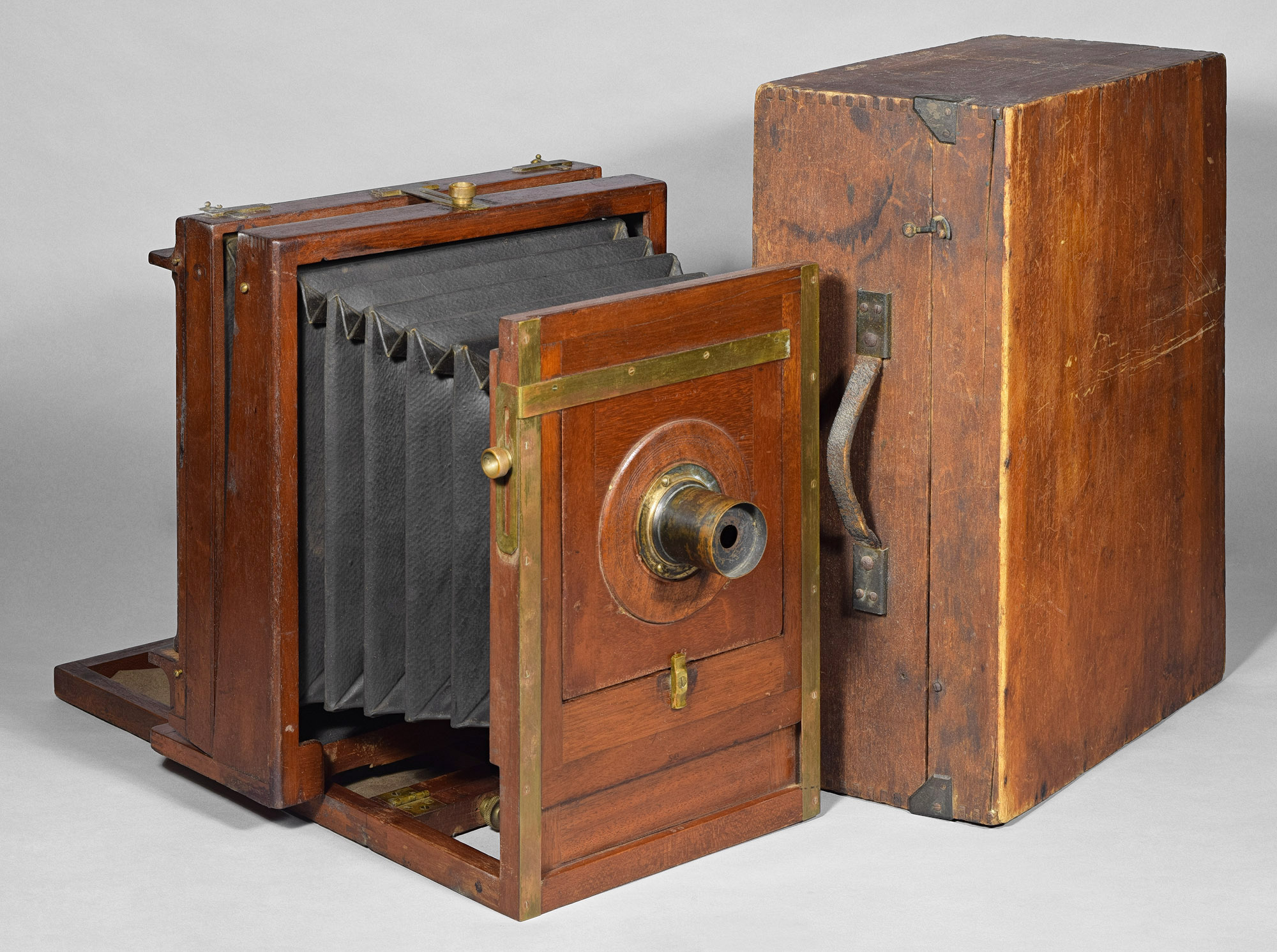
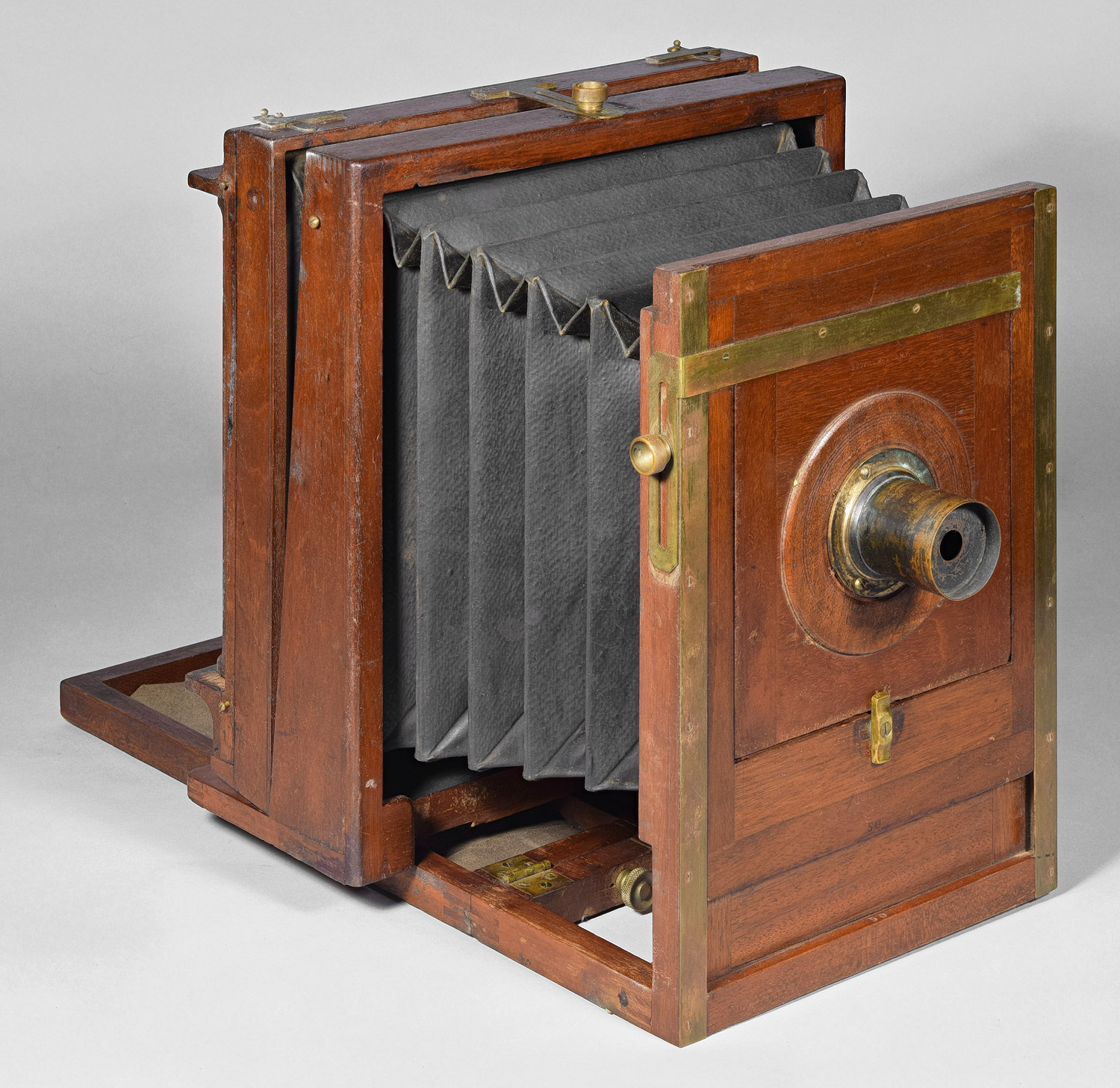
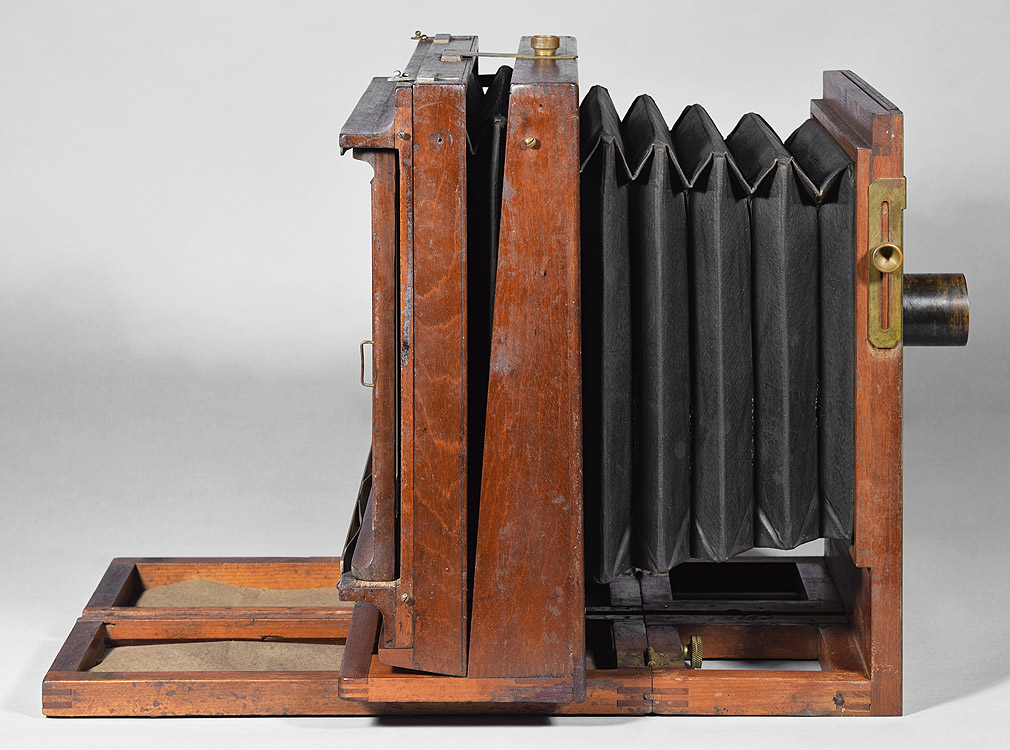
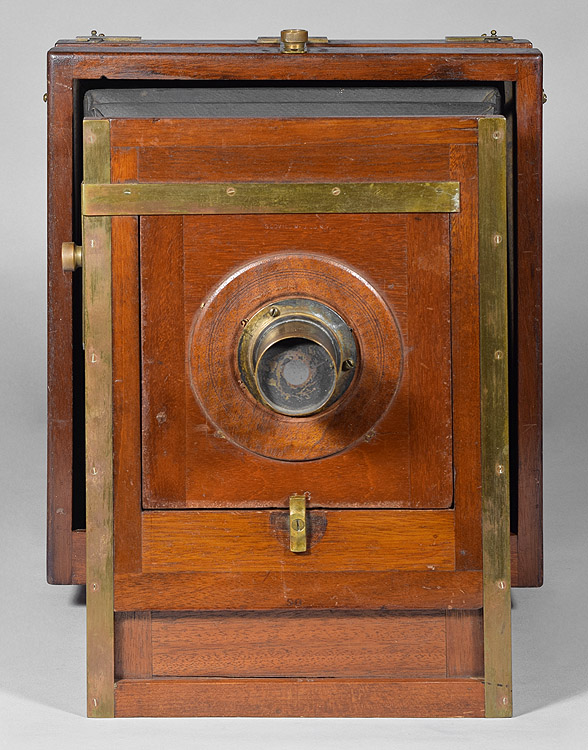
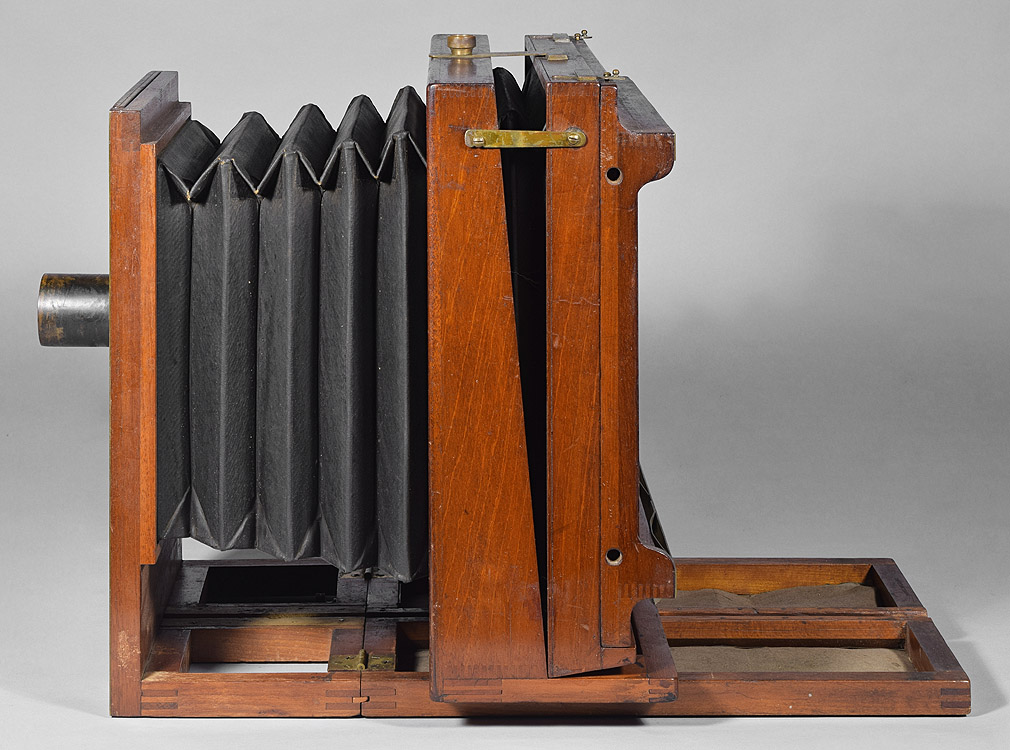
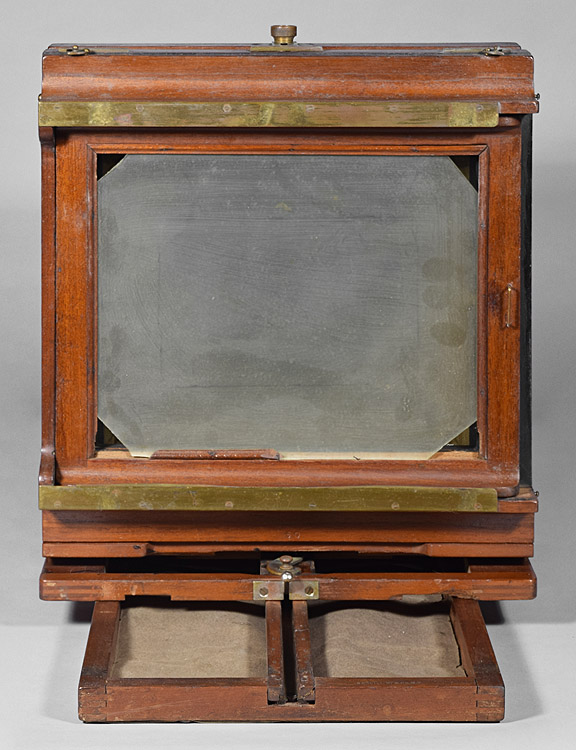

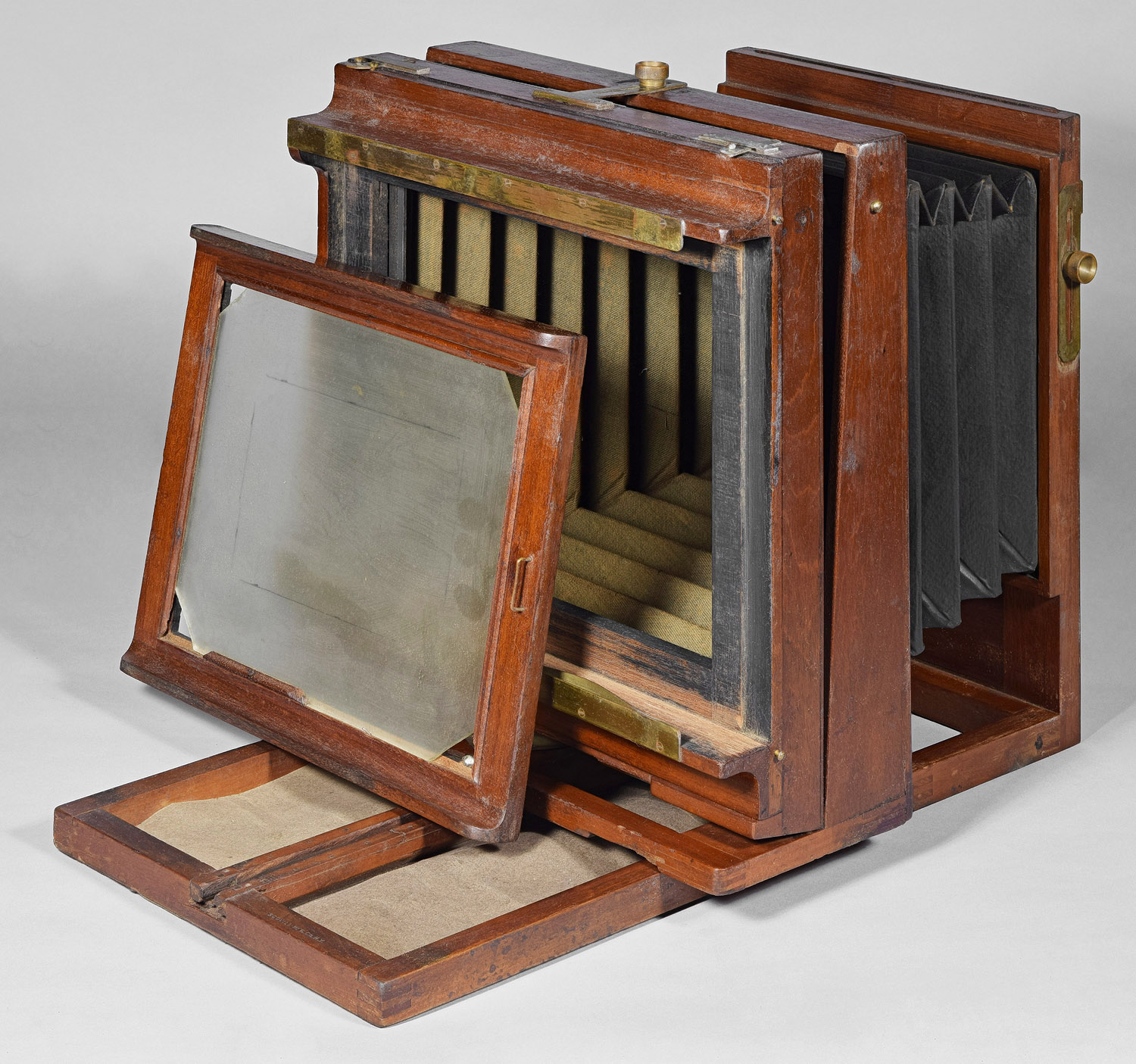
The bottom of the camera shows a fabric cover on the
rear extension, installed by the nineteenth century owner to create
something like the wooden covers found on some early back-focus cameras,
for example, the 11x14 Acme Variation 1
shown below.
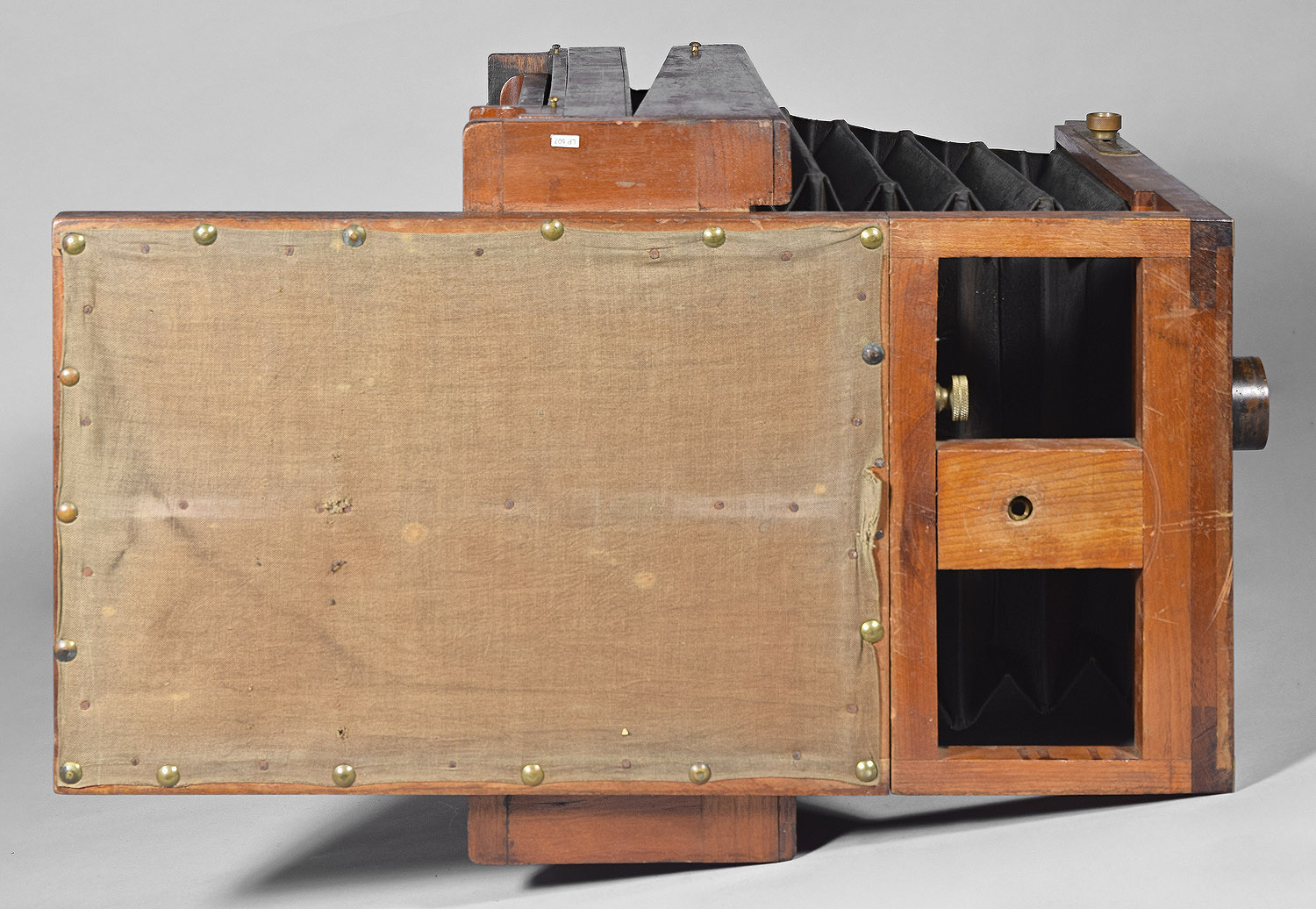
Stamp, rear of platform: "Scovill Mfg. Co., N.Y."
This stamp (on Camera No. 50) is the exact same stamp used on the 11x14"
Camera No. 218, shown below.

Two stamps of the serial number "50": on the front
surface of the rising piece on the front standard, and on the top
surface of the platform under the front standard.
Note that the screws in the brass guides/wear guards are aligned
vertically.

Two more stamps of the serial number "50": one on the
bottom of the vertically swinging part of the rear standard (top), and
one on the horizontally swing part of the rear standard (bottom).
The lever between the serial numbers locks the focus of the camera.
The round ball just below the serial numbers is attached to a lever that
locks the horizontal swing.

Stamp on the top of the lens board: "Scovill Mfg.
Co., N.Y. While lens boards on view cameras are not always
original equipment, this on bears the exact same stamp as the rear of
the platform (photo above), and so undoubtedly is the lens board that
was purchased along with the camera.
As usual for American Optical products, the screw slots of the
horizontal brass bar under which the lens board sits are aligned
horizontally, and the screw slots of the vertical brass guides/wear
guards are aligned vertically.
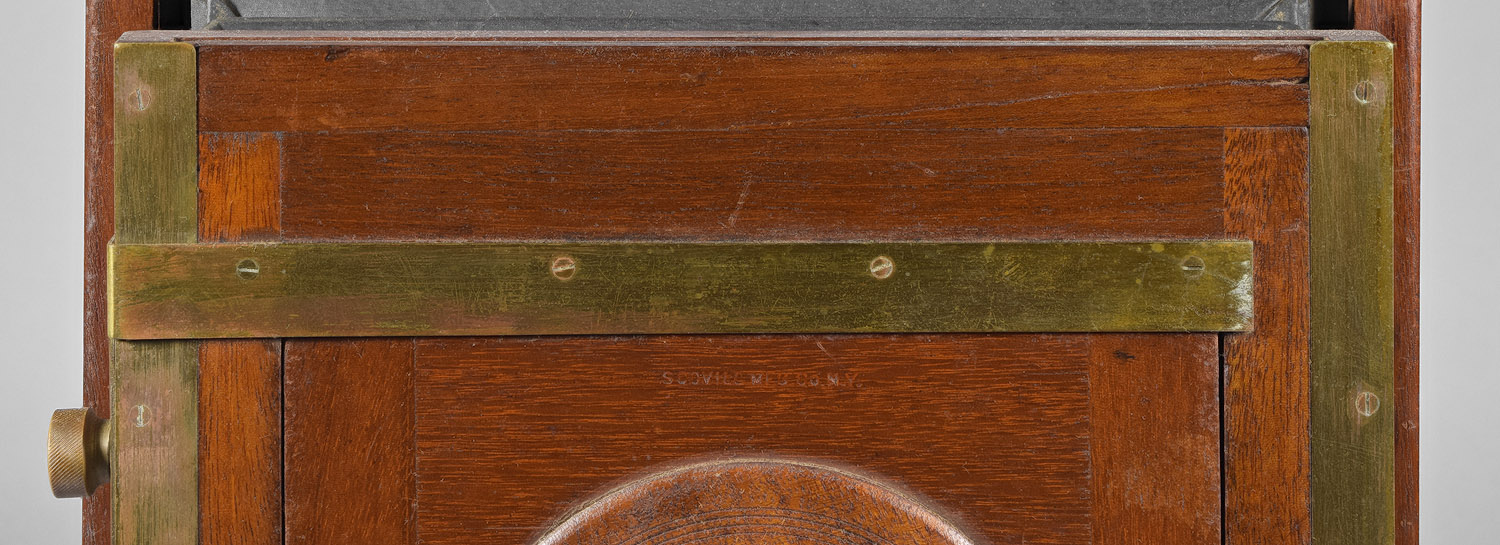
Scovill Mfg. Co. 8 x 10", Scovill
Label instead of American Optical Serial No.
185
Incredibly, this camera, like the one above,
has also had a huge hole made in its lens board. This time, I had
to make the patch.
This one was also missing its back as well as the shelf on which the
back rests. The original back would be identical to all the others
on this web page.

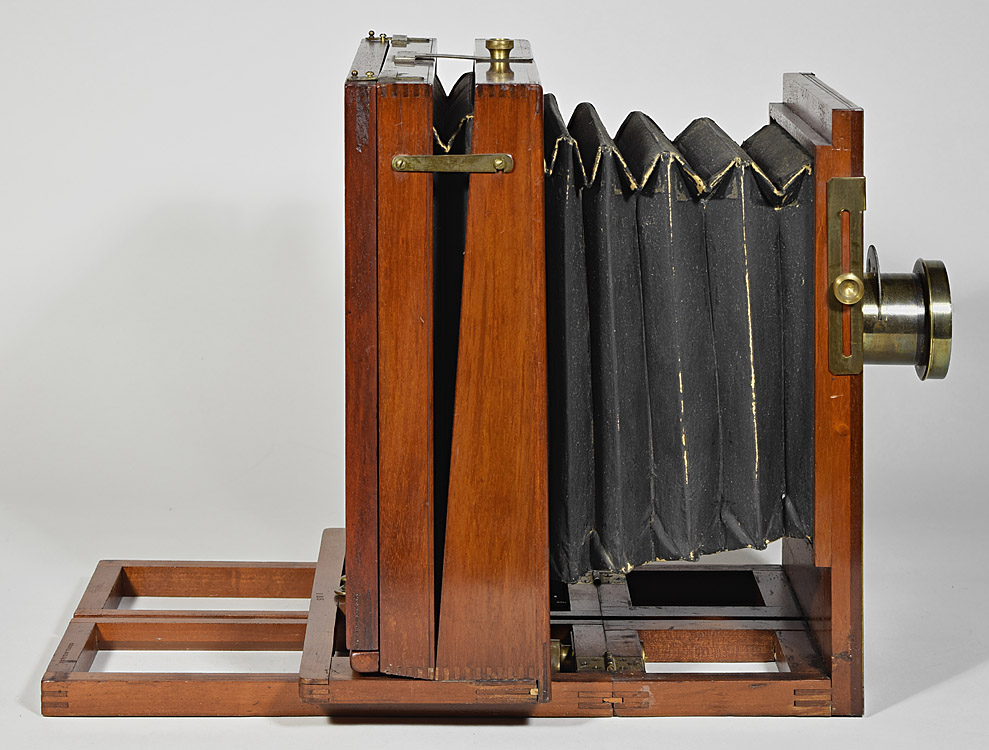
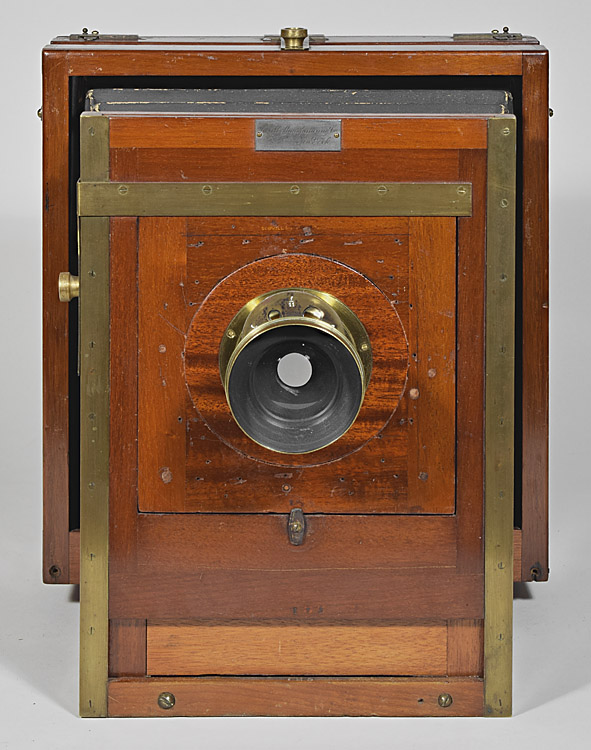
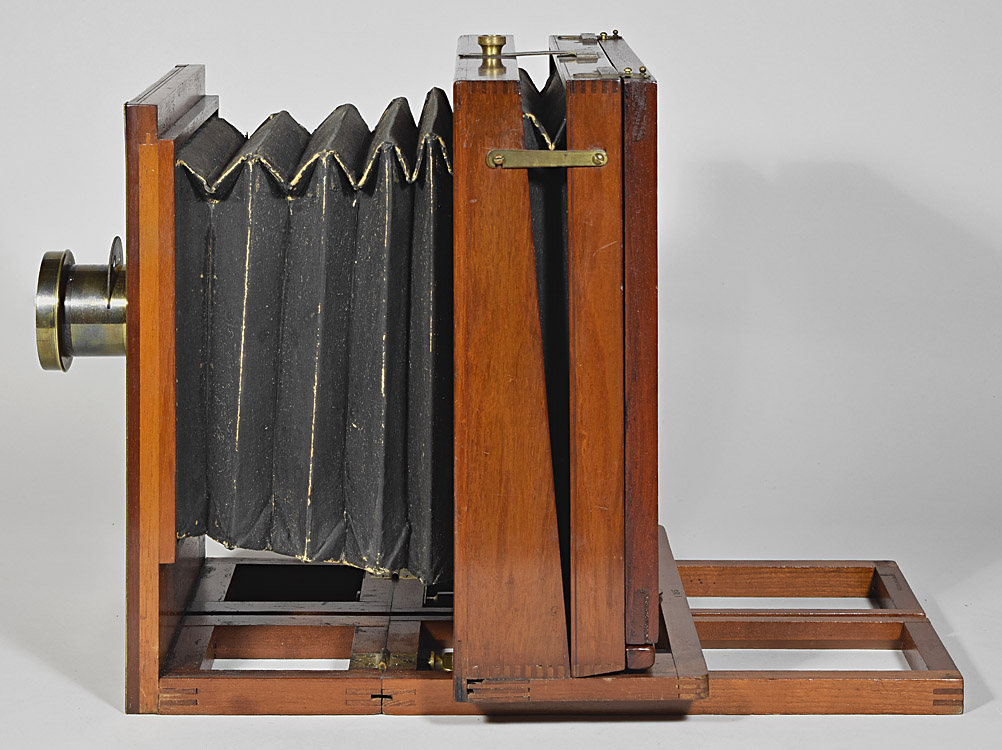

This camera was missing
its normal ~2" thick spring back as well as the shelf on which the back
rests.
Impossible to recreate something like the original, I have constructed a
simple ground glass frame and shelf, just to make the camera look more
like a camera, and to see the view through the nice Somerville wide
angle rapid rectilinear lens.
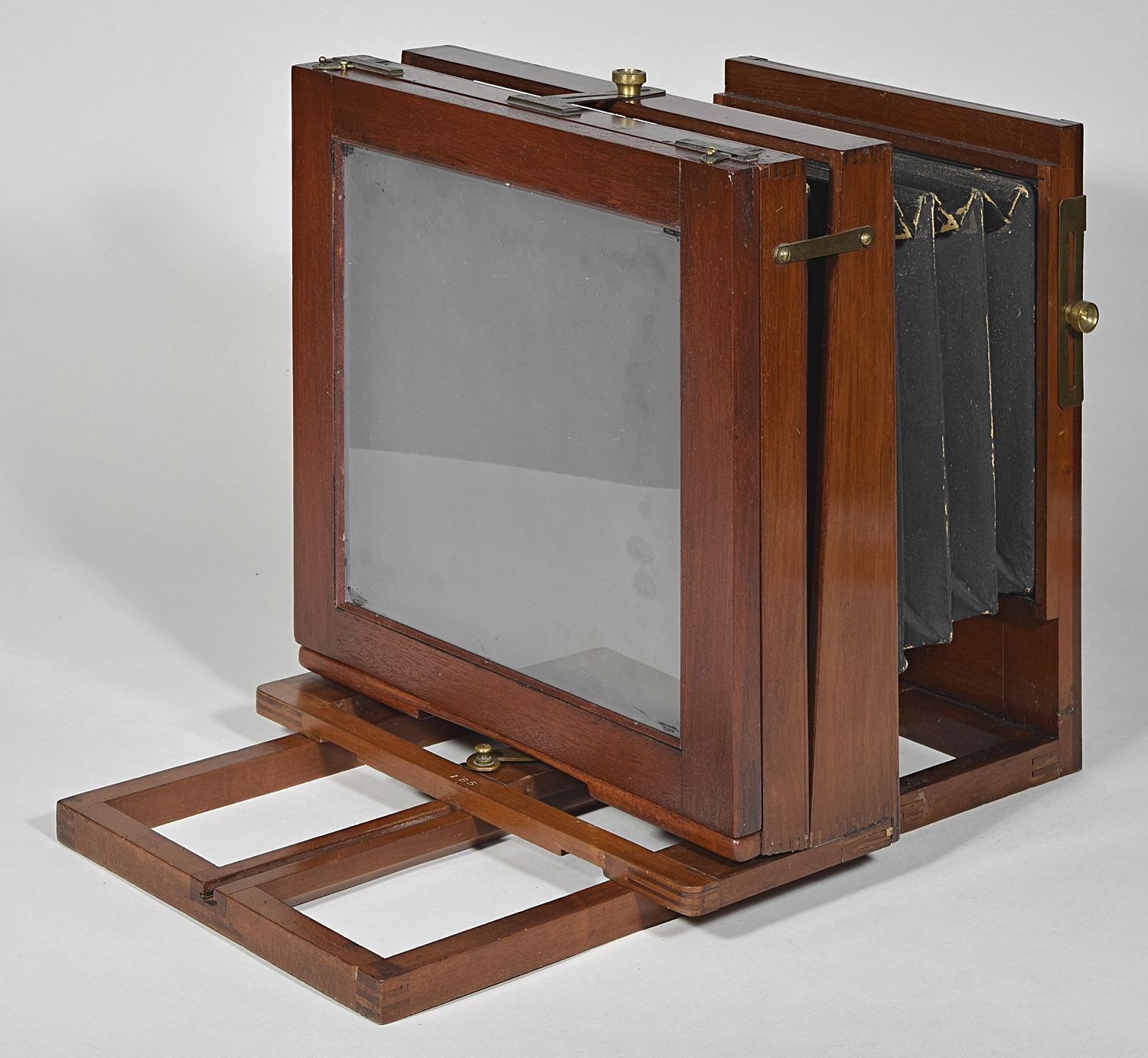
Bottom
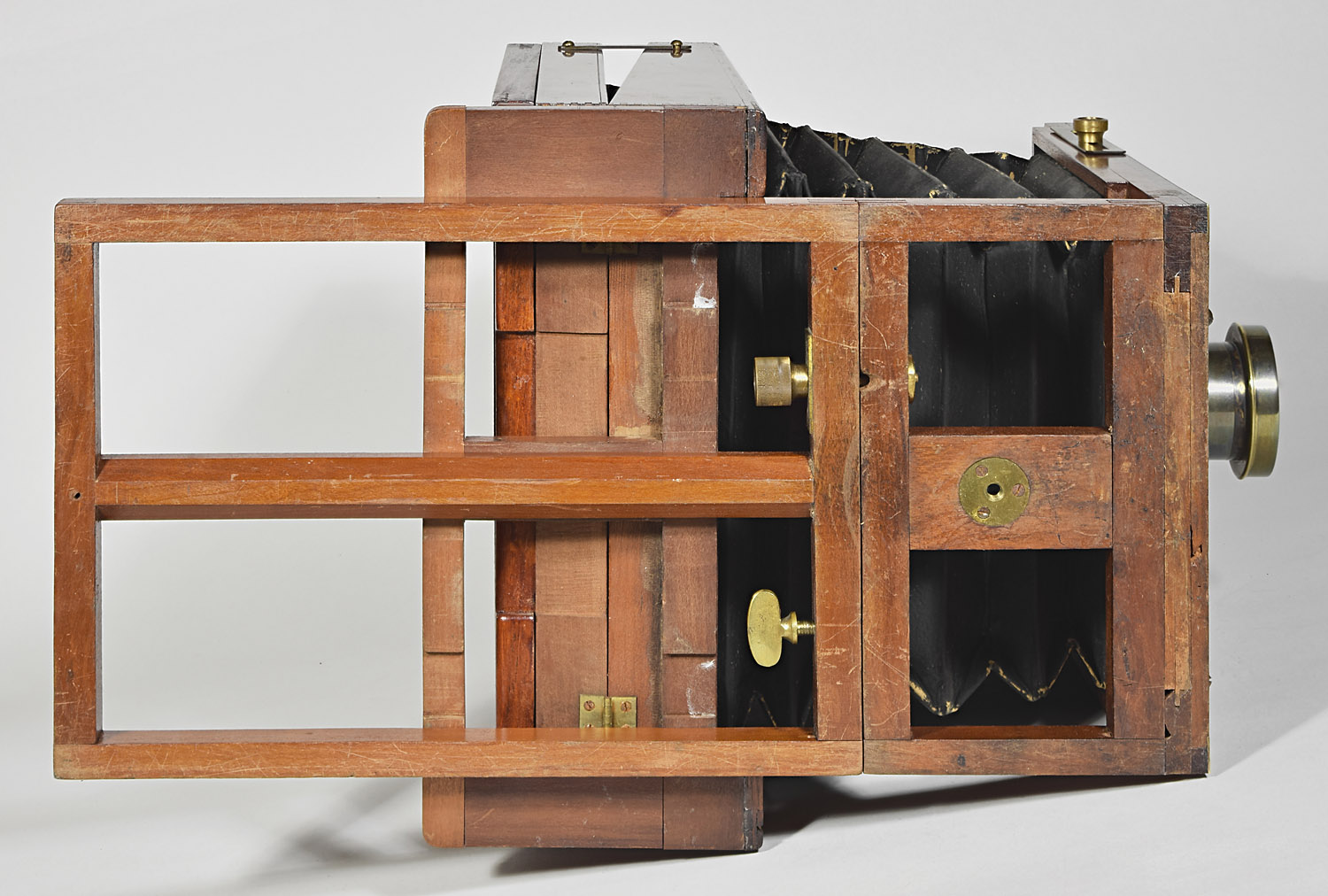
Top Label, probably nickel-plated brass: "Scovill
Manufacturing Co., / New York". These are fairly rare on Acme
cameras. Stamp, rear of folding part of platform:
"Scovill Mfg. Co., N.Y." Stamp, upper part of lens
board: "Scovill Mfg. Co., N.Y." Stamp, Serial No. 185, rear deck of movable
platform. As usual, the numbers are punched separately. Two more stamps of Serial
No. 185, on the lower rising part of the front standard, and on the top
surface of the front nose of the fixed platform.
Two stamps on rear base: "Scovill Mfg. Co., N.Y."
(one stamp)
and the serial number "218" (three stamps - the numbers stamped separately).
The "218" is stamped in three additional places on the camera: 1) the
front surface of the bottom of the rising piece of the front standard,
2) the top surface of the main platform right at the front of the
camera, and 3) the top surface of the moving platform of the rear
standard.
Celluloid Label: "The Scovill & Adams Co.
/ New York" on top of the front standard.
Two stamps on rear base: "Scovill Mfg. Co., N.Y."
(one stamp)
and the serial number "501" (three stamps - the numbers stamped separately) Manufacturer:
Scovill Mfg. Co., , probably produced in the New
Haven Factory, former Samuel Peck & Co. factory
Scovill / American Optical made a number of
of cone or tapered bellows cameras. The following is an excerpt
from
American Optical/Scovill Back Focus Tapering Bellows Field View Cameras - Chronology and Design
detailing the history of Scovill/American Optical camera models of this basic
type.
Acme Reversible Back View Box / Back Focus Cone View Camera Model
Variations:
The
Acme View Camera
can be found in catalogs and advertising
approximately from 1884 through 1895, although there was a similar
Scovill
tapered bellows view camera during the wet plate era (see
American
Optical New Camera Box).
Depending on the catalog and the year, the Acme was referred to as one of at
least three
names: Acme View Camera,
Back Focus Cone View Camera, or Reversible Back
View Camera. Despite its
workmanlike design, it was highly finished, showing French polish on the wood, draw file finish on the
hardware, and screw slots that were laboriously aligned along the length
of each brass part then filed down perfectly even with the part. During the
Scovill Mfg. Co.
era (<1889), sometimes this model's labels read: "American Optical
Co., - Scovill Mfg. Co., N.Y. Prop't'rs" but sometimes they read
simply "Scovill Mfg. Co., N.Y.". During the
Scovill & Adams Co.
era (1889-1901), the labels merely read: "The Scovill & Adams Co. -
New York". Despite the relatively consistent high quality construction and appearance, it is
probable that the ones labeled American Optical were manufactured in the New York City factory of
American Optical, and those labeled Scovill or Scovill and
Adams were manufactured in the New Haven, CT factory formerly the
Samuel Peck & Co. factory.
So far, four variations have
been seen:
Acme
Reversible Back View Camera Variation 1.0: This is the camera as shown
in the advertising, including a ~2" thick removable, reversible back.
To take a photograph, the back's ground glass frame is slid out and
replaced by the plate holder.
All examples are marked Scovill or Scovill & Adams, and therefore
thought to have been made in Scovill's New Haven, CT factory, formerly
the Samuel Peck & Co. factory.
Acme Reversible Back View Camera Variation 1.5:
This variation, being represented by only one example so far, is
identical to Variation 1.0 except that it has rack and pinion focus
rather than push-pull focus.
Acme
Reversible Back View Camera Variation 2.0: This variation also has a removable,
reversible back, but it also has an interior ground glass frame that is
released via a lever. The plate holder would then be
inserted into the hole vacated by the ground glass frame. This
variation is assumed to be c.1885, since this same back is pictured in
1885 advertising for the
American
Optical Ripley Camera. It may, therefore, be the first variation of the
Acme chronologically.
But why then would the advertising engraving show the
Variation 1.0, above. I
believe that Variation 2.0 was a
very short lived, expensive to produce version of the
Acme, the
Variation 1.0 being the original
version made before Variation 2.0,
but also made after Variation 2.0
well into the Scovill & Adams era.
Acme
Reversible Back View Camera Variation 3.0: This variation has yet a third
variation of removable, reversible back, which, in this case, has spring
back that, unlike
the other variations, does not have
to be removed to insert a plate holder - a very handy improvement.
It has a
complex set of four springs that can be set open, allowing the plate holder to be
easily slid under it, then released to tightly hold the plate holder in
place. This type of back is also seen in other high end American Optical
cameras of the Scovill & Adams Co. era,
such as the Compact View Variation 1.0,
the Compact View / Irving View Variation 2.0,
the Elm City View, the
Irving View Variation 1.0, the
Irving View Variation 1.2, and the
Star View Camera.
References:
Back to American Optical
Co. / Scovill Mfg. Co. (alphabetical)
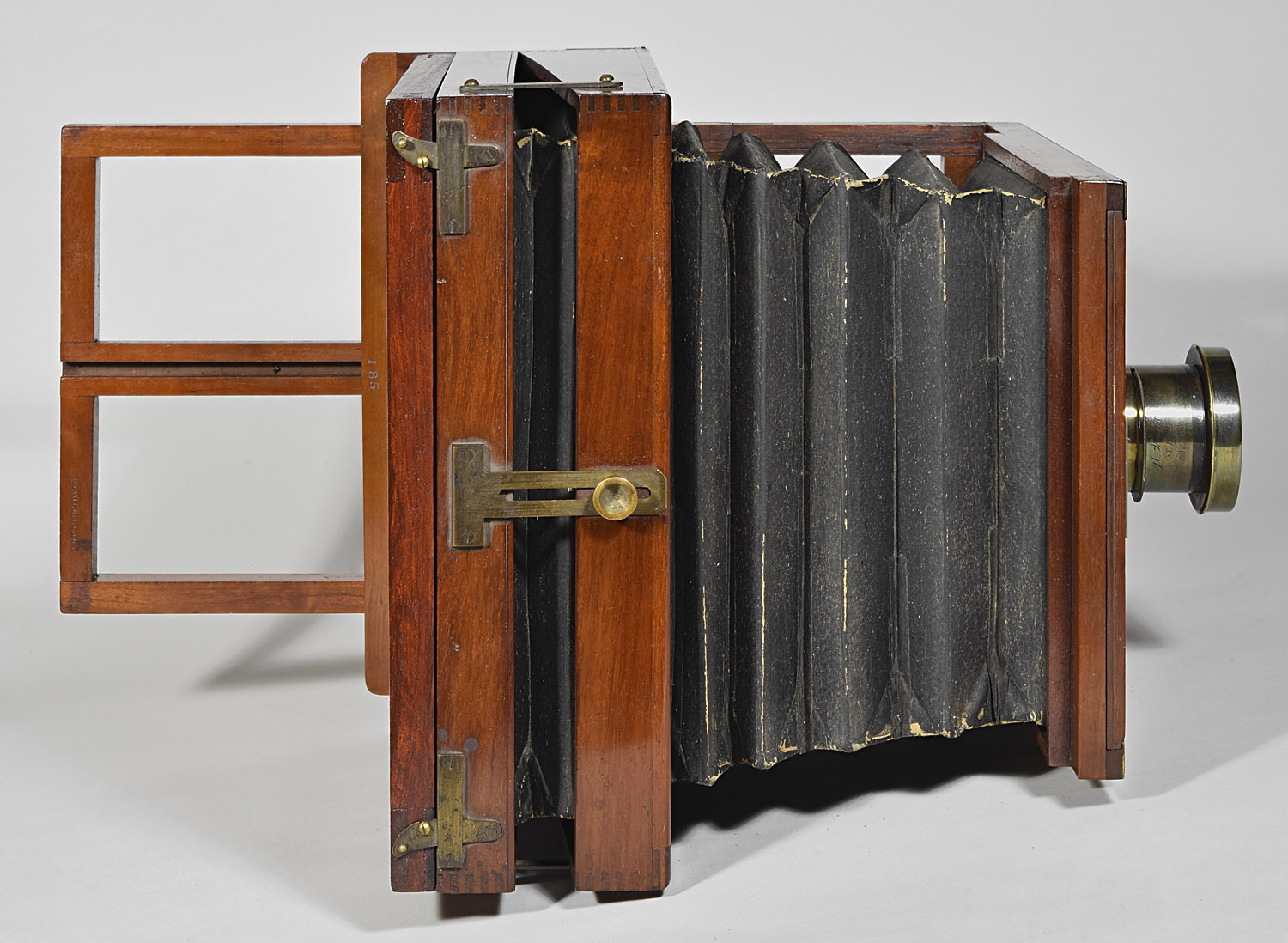
This label is identical to one found on a
Scovill Albion Camera
Variation 1.


This is the same message, but a different (smaller and squatter font
style) stamp than the one used on the rear of the platform, above.
Because the lens board was apparently original to the camera, but had a
huge (~5" diameter) hole in it, the hole was patched so that an
appropriate lens could be installed without using a replacement lens
board.
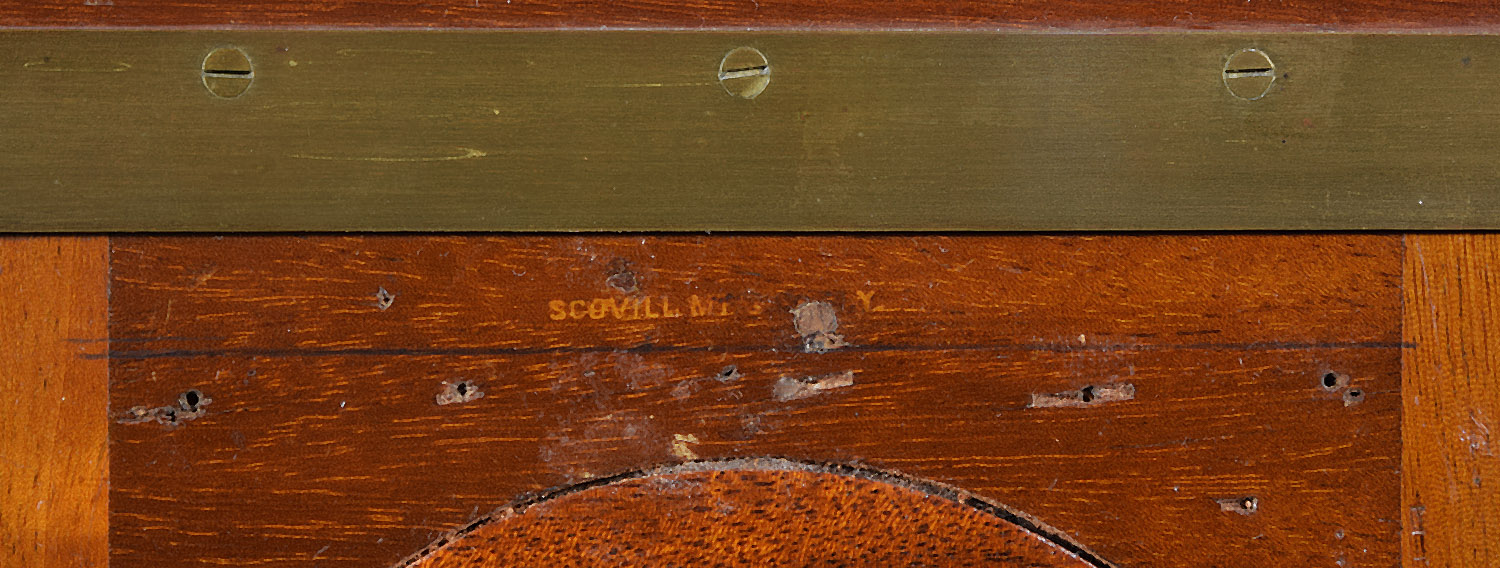

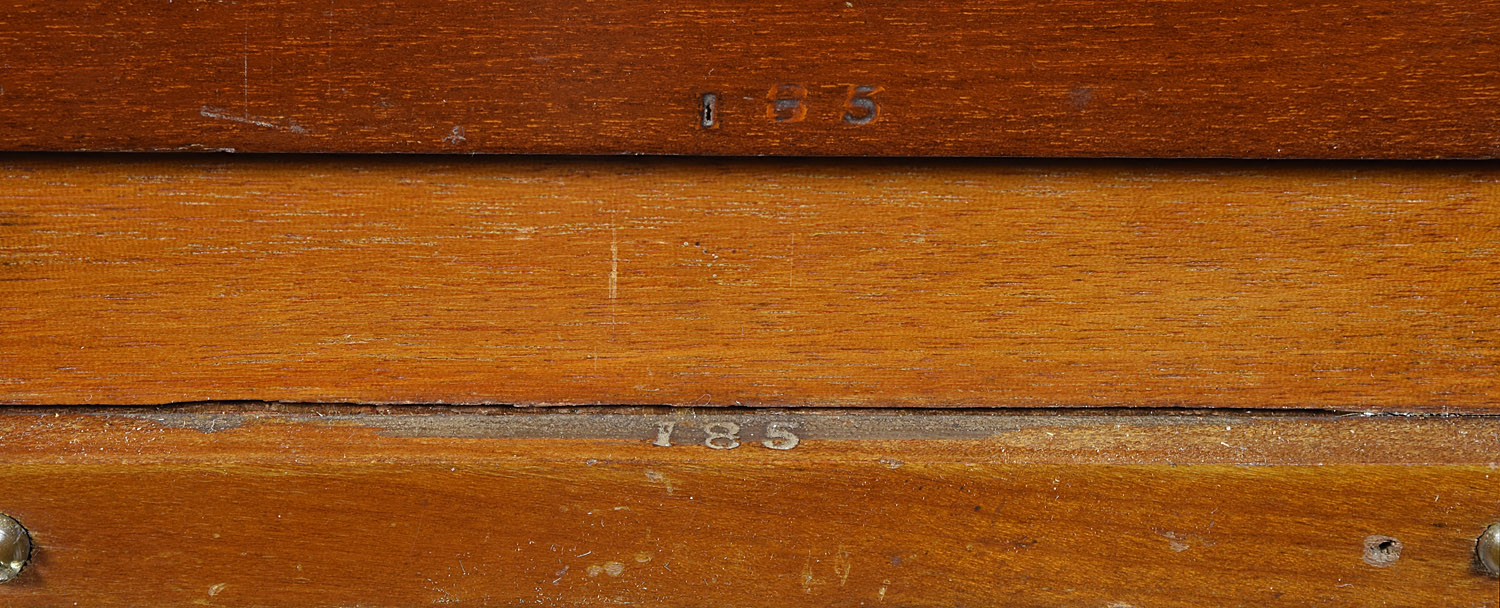
Scovill Mfg.
Co. 11 x 14",
single swing, No Label, Serial No. 218.
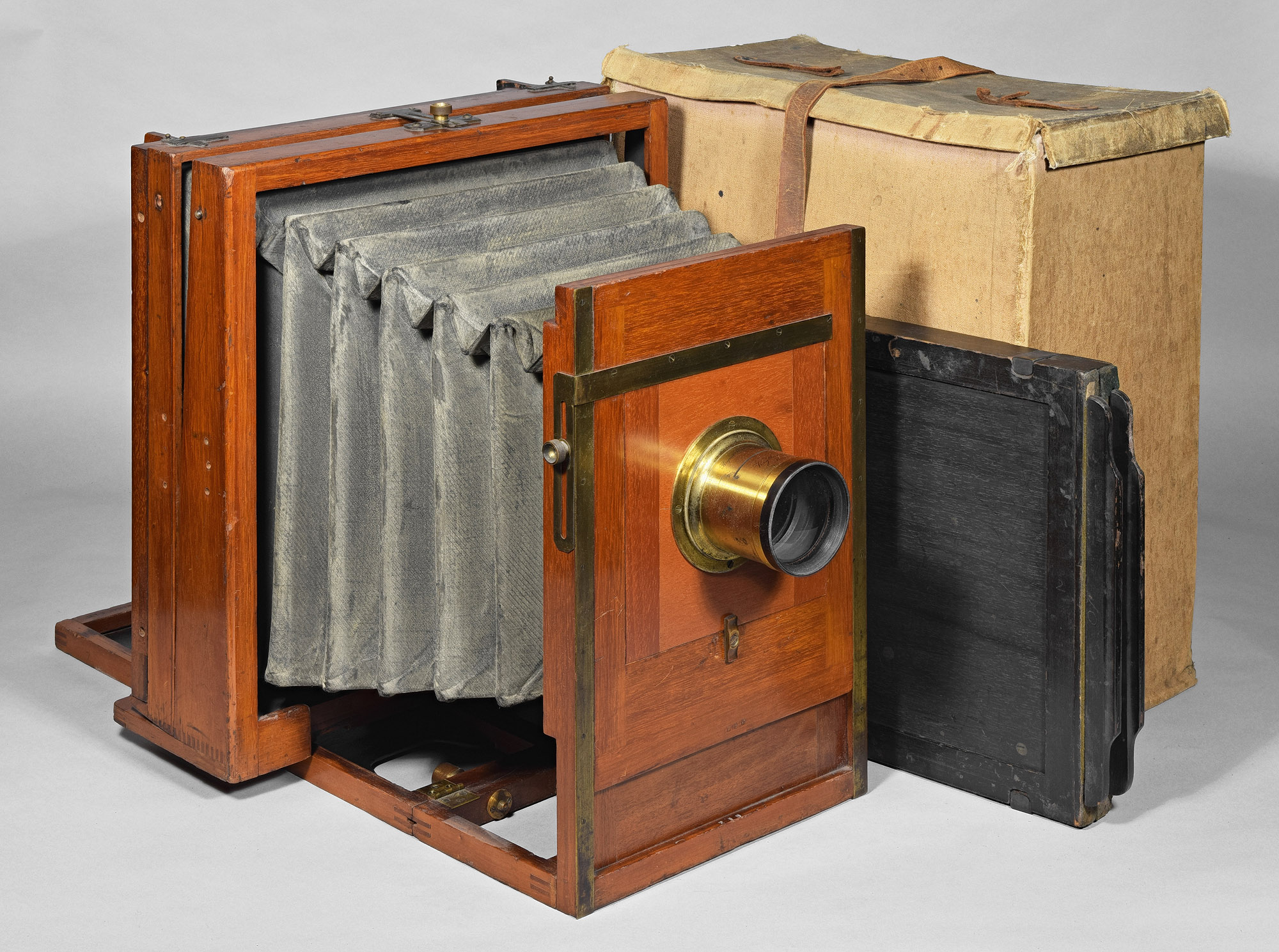
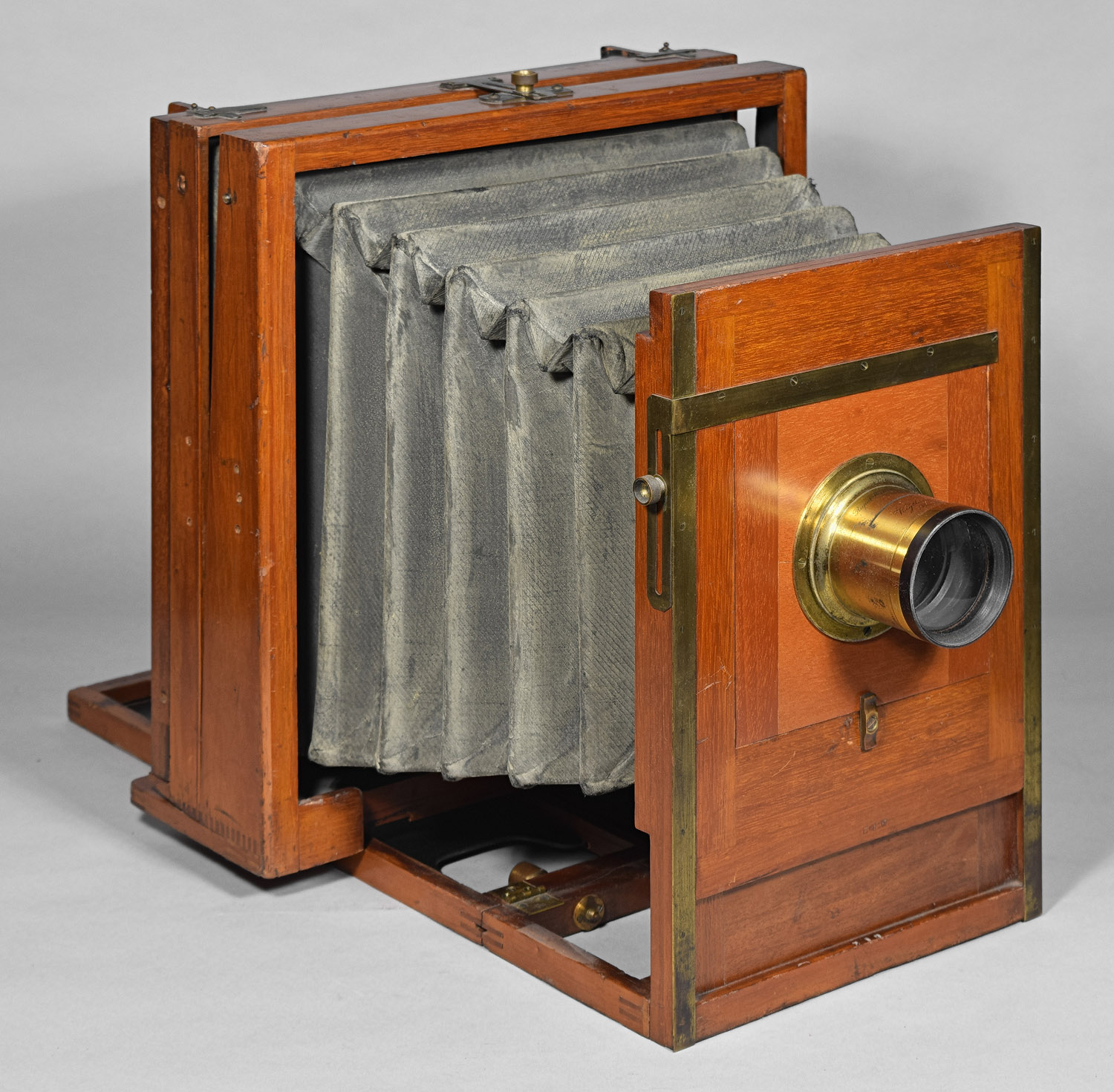
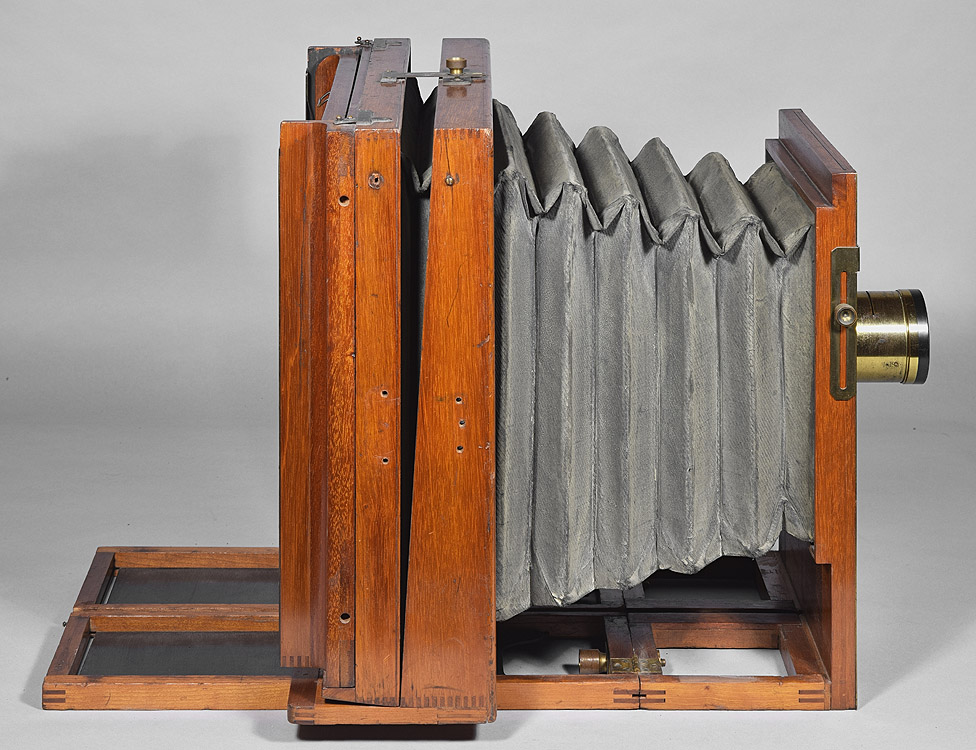
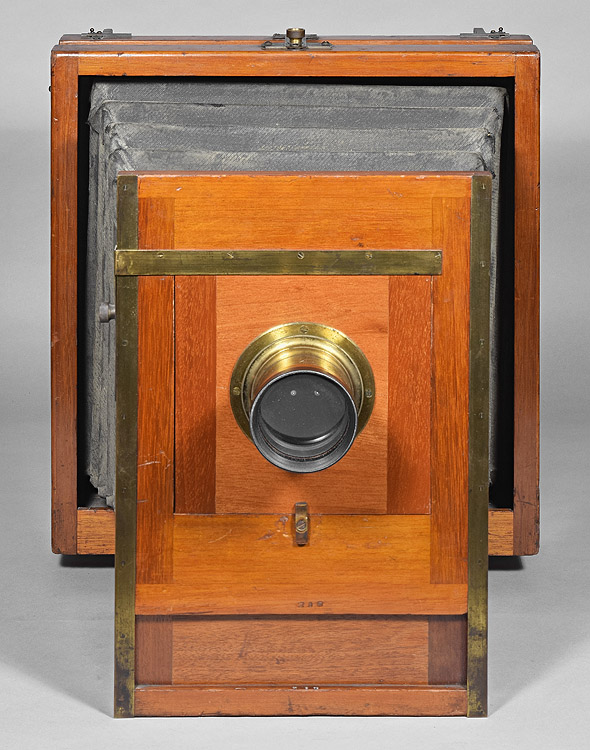
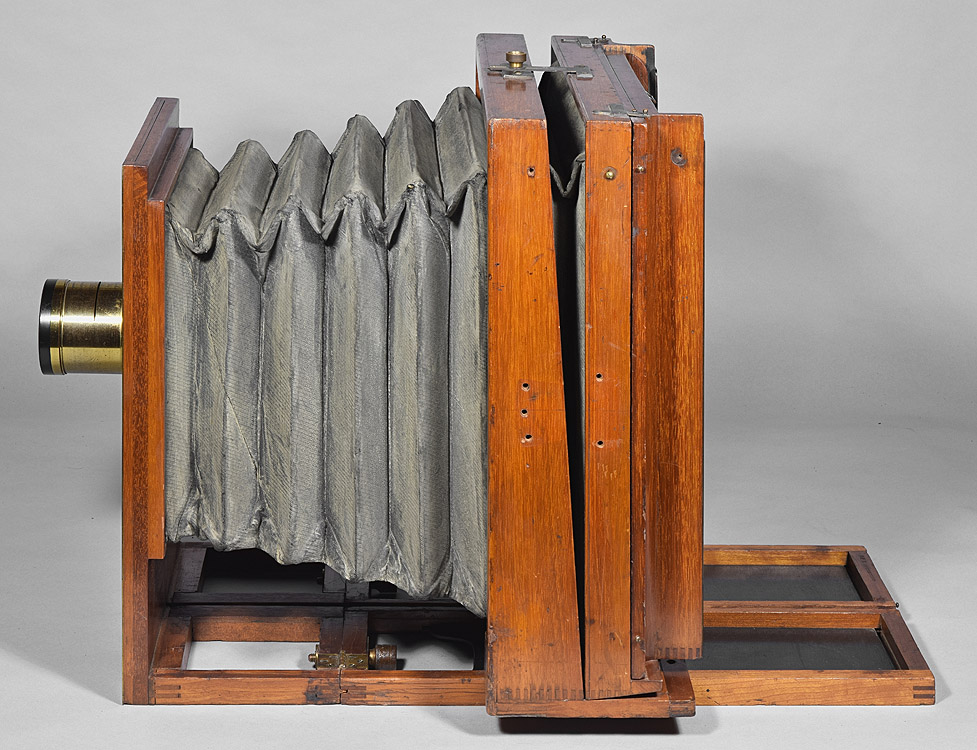

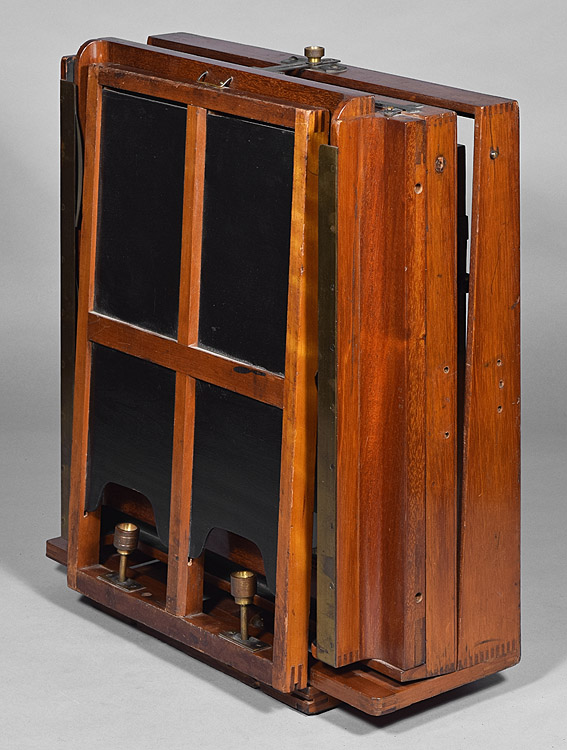
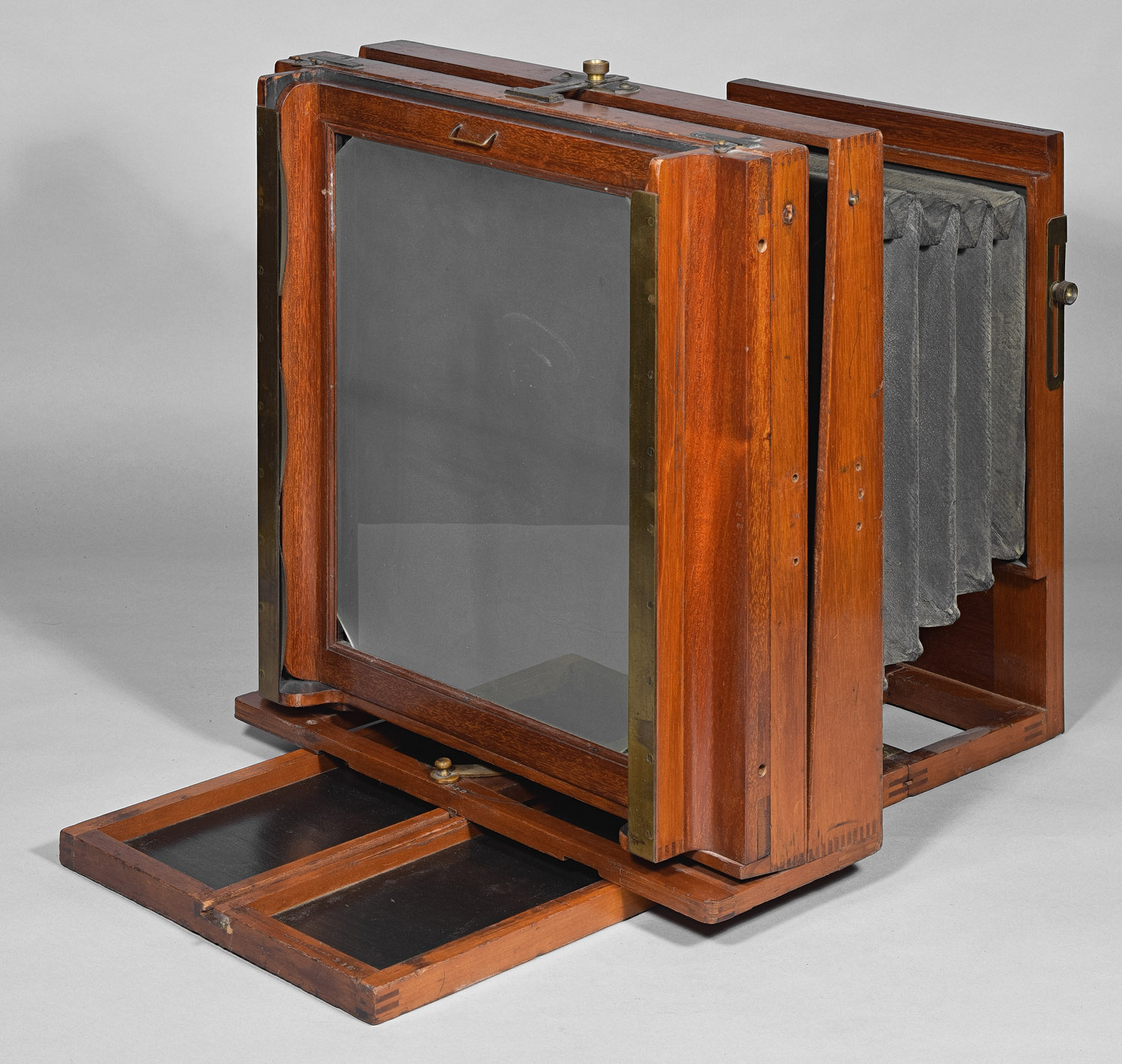

This stamp (on Camera
No. 218) is the exact same stamp used on the 8x10" Camera No. 50, shown
above.

Scovill &
Adams Co. 6½ x 8½",
double swing version, Serial (or Assembly) No. 3.
a camera made 1889-1900, since it is labeled "The Scovill &
Adams Co. - New York".
Note that it is not labeled as American
Optical, even though the camera bears all the hallmarks of an American Optical product - fine French polish finish for the wood, draw file
finish for the hardware, and screw slots aligned.
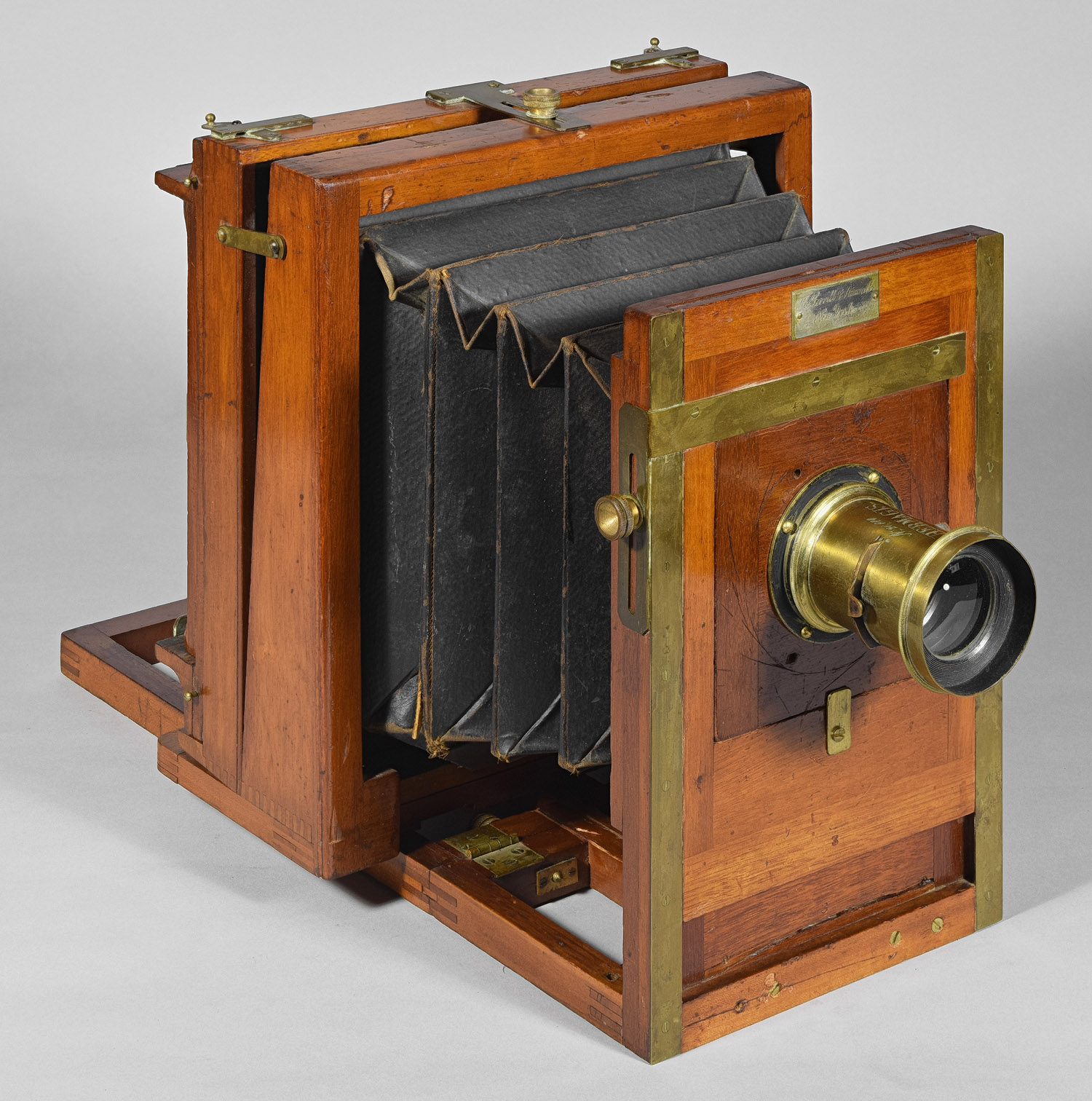
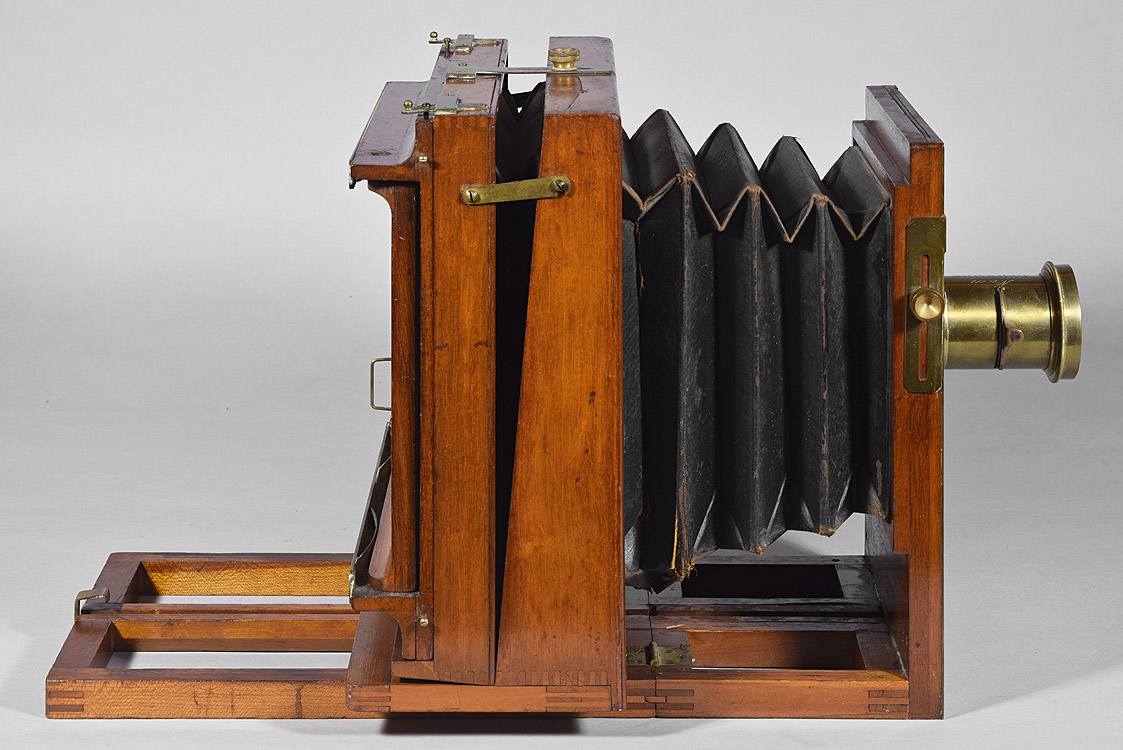
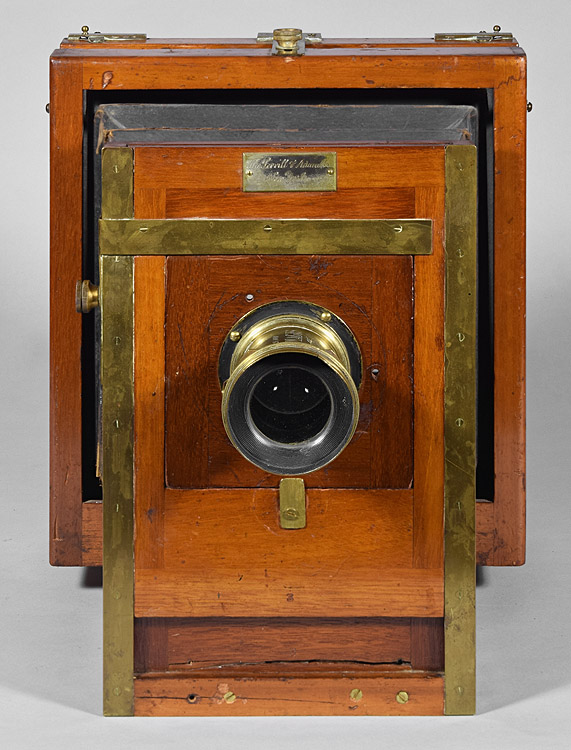
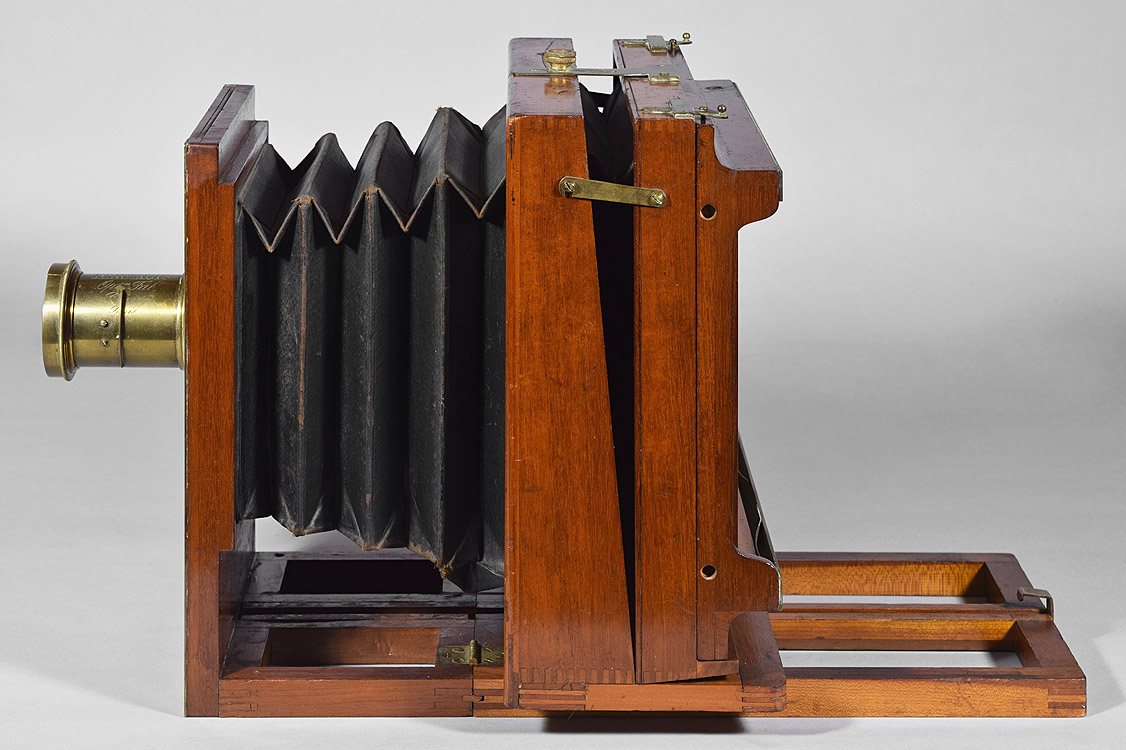
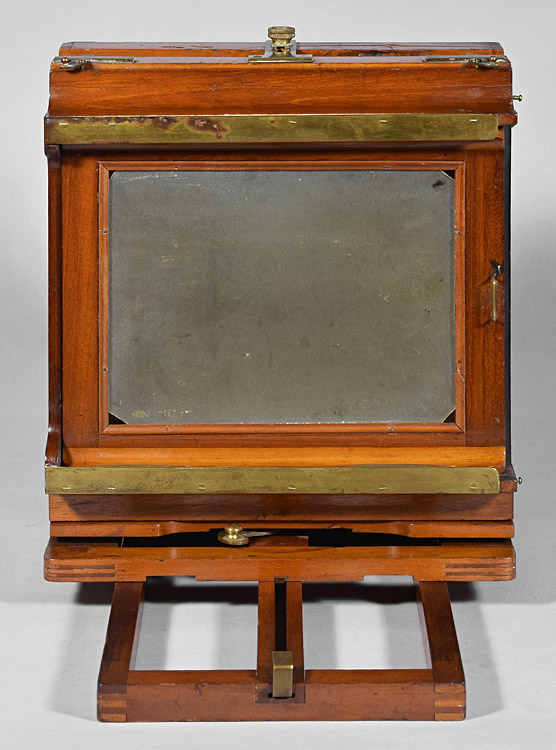
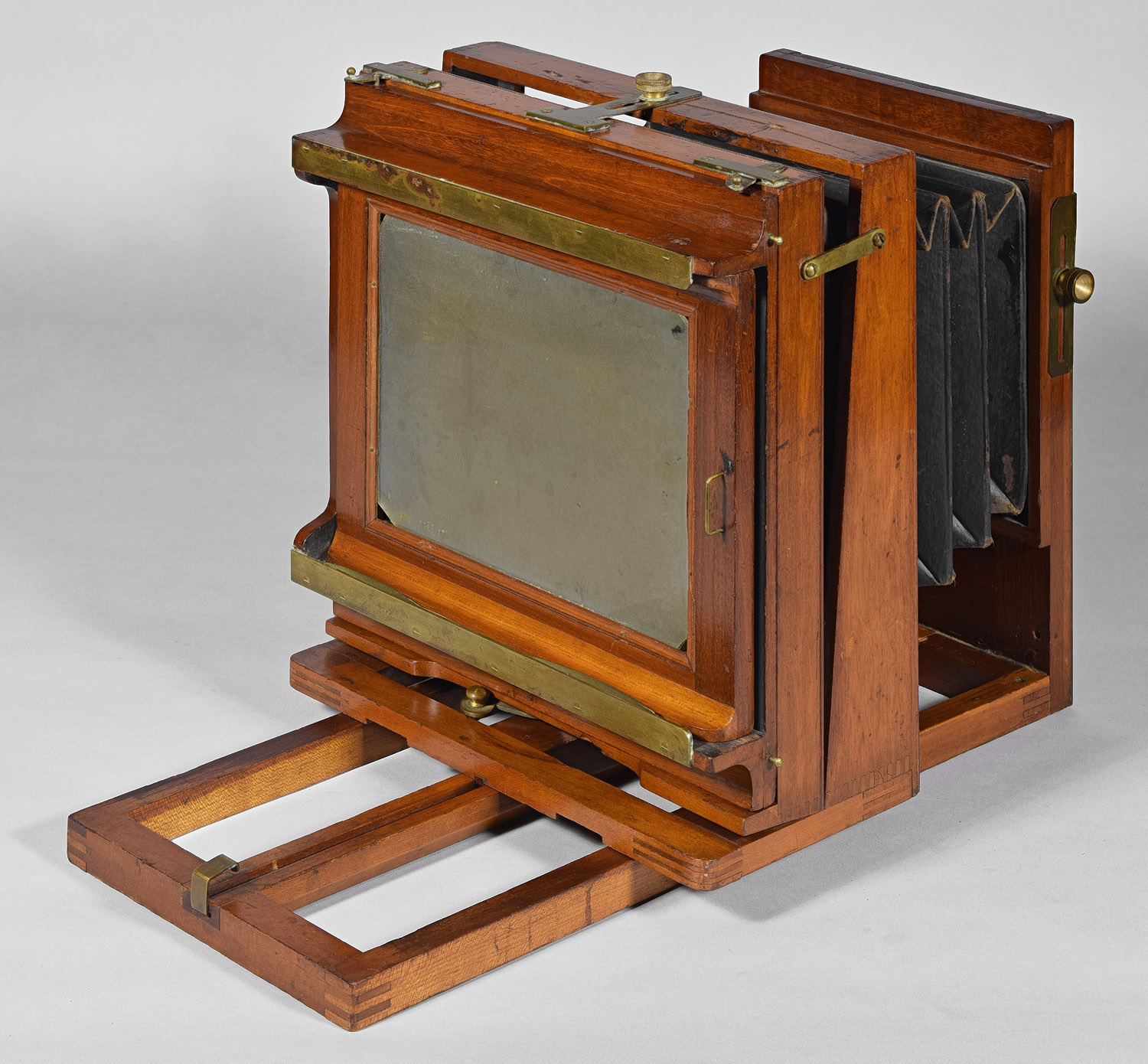
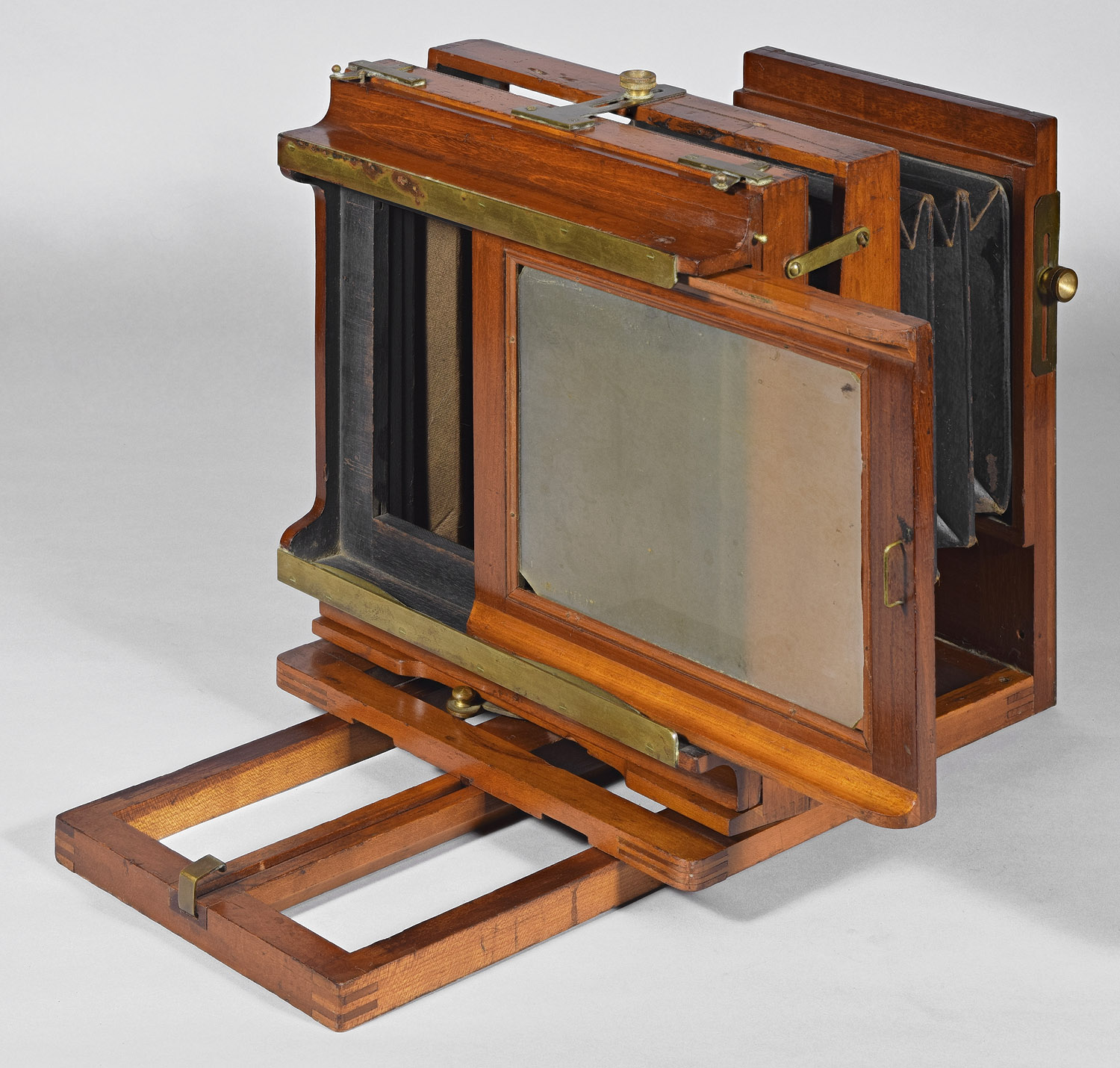

Label, silver-colored metal (probably German silver):
"The Scovill & Adams Co. - New York". Note the vertical alignment
of the screw slots in the lens board retaining strip, and the vertical
alignment of screw slots in the two edge brass guides/edge protectors.
The alignment is the result of the camera maker randomly choosing screws
for each instance until the slots align. Also, the screws are
initially left slightly above the level of their brass substrate, then
are filed down even with the surface during the draw file process,
resulting in the edge of the screw head being almost invisible, blending
in so well with the brass surface.

Stamp, probably the camera's assembly number "3"
hidden under the removable camera back, on the top surface of the
movable rear standard platform/base. An assembly number assists
the camera maker to produce more than one camera at a time without
mixing up parts that, while very close in size to similar parts, do not
precisely fit any other camera than the one for which it was made.

14 x 17"
Scovill & Adams Co. and Scovill Mfg. Co. markings
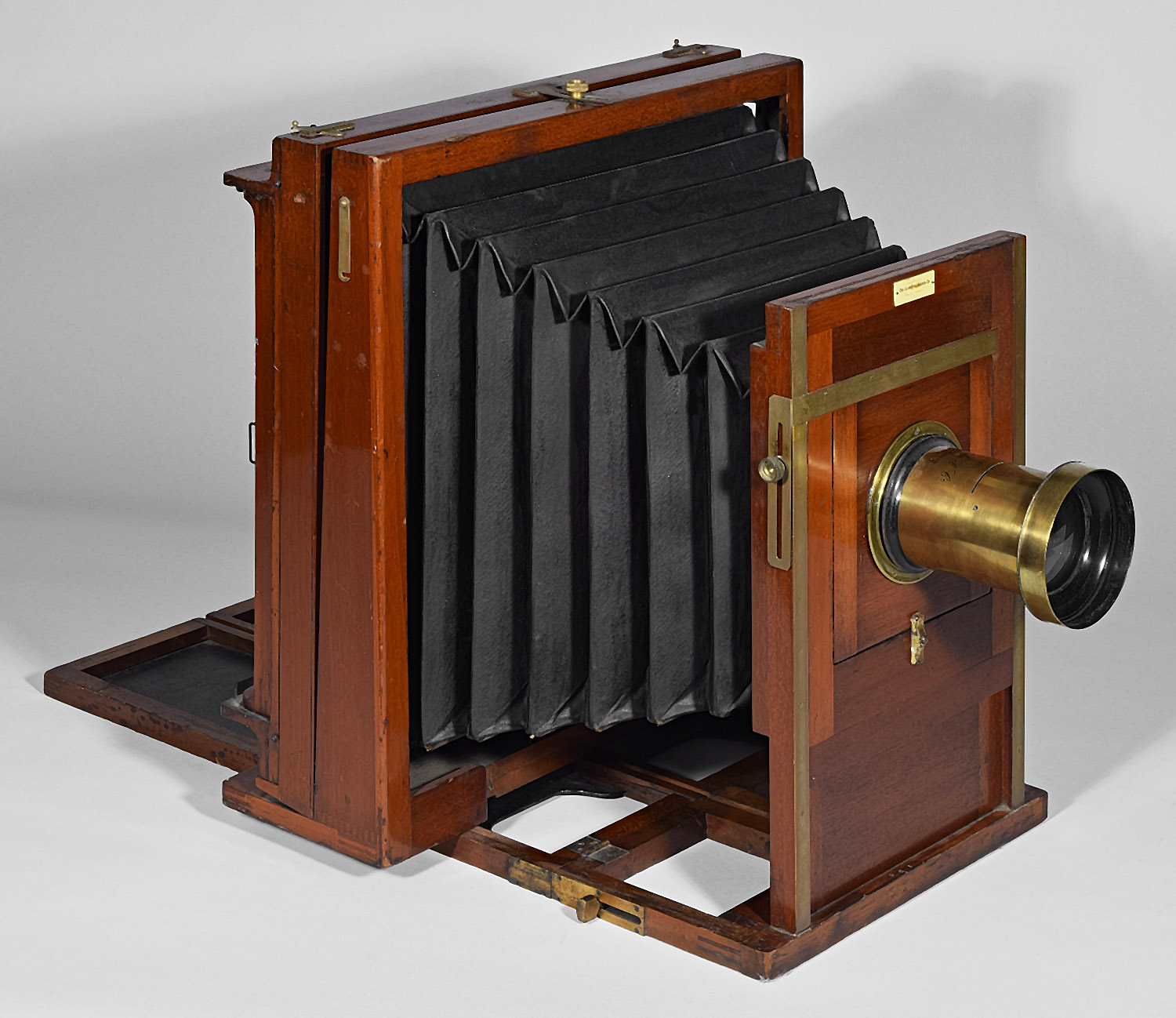
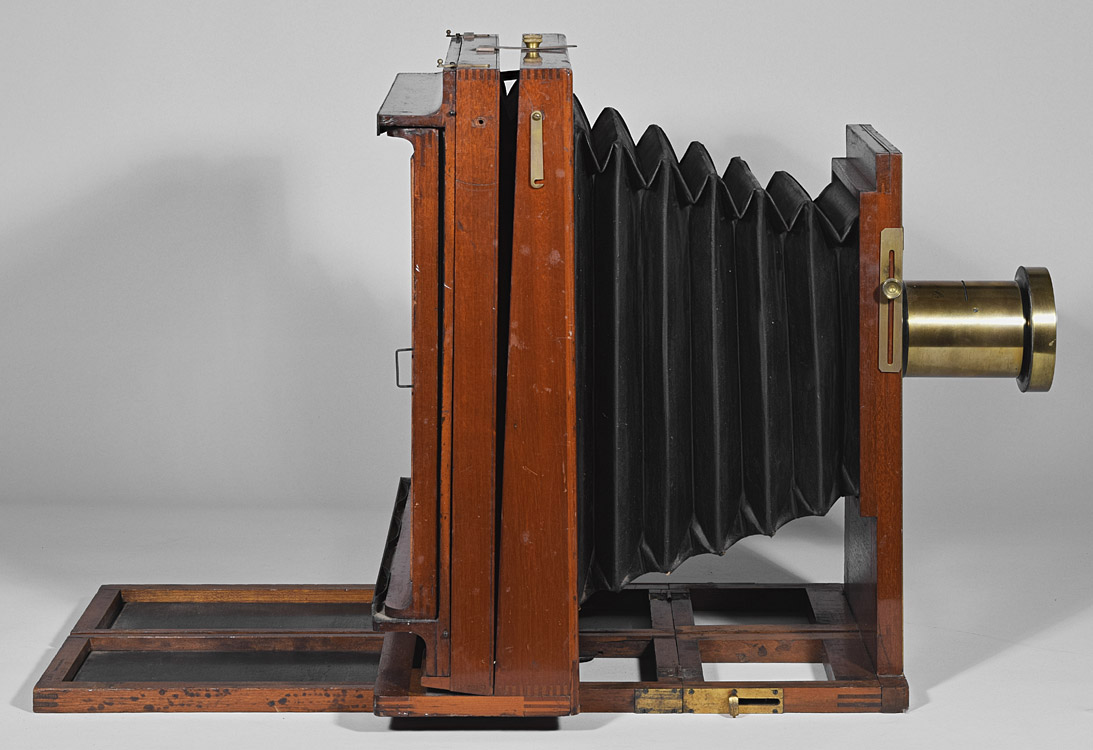
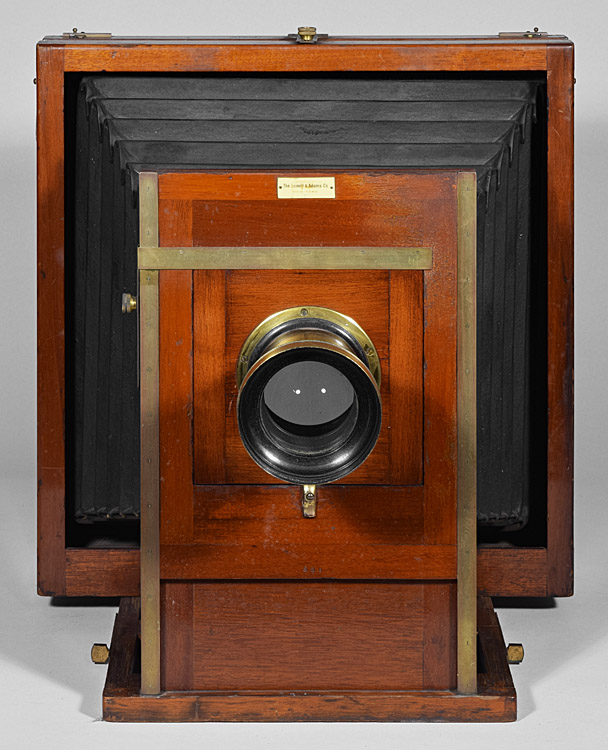

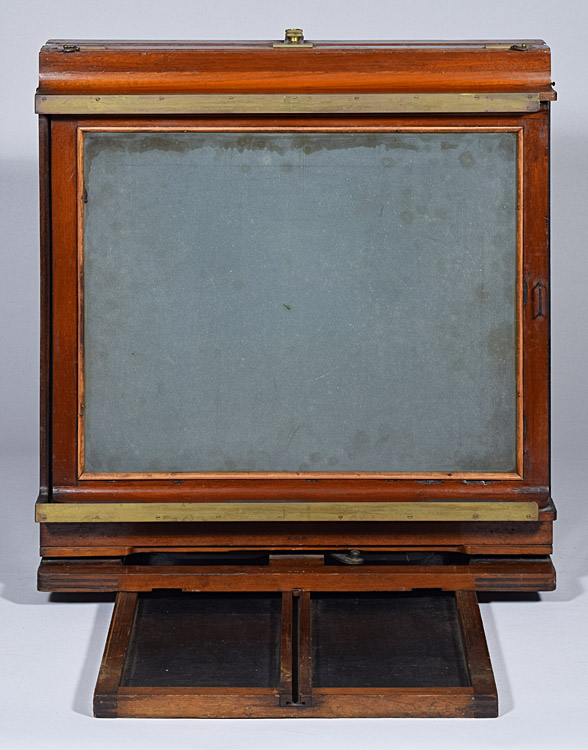
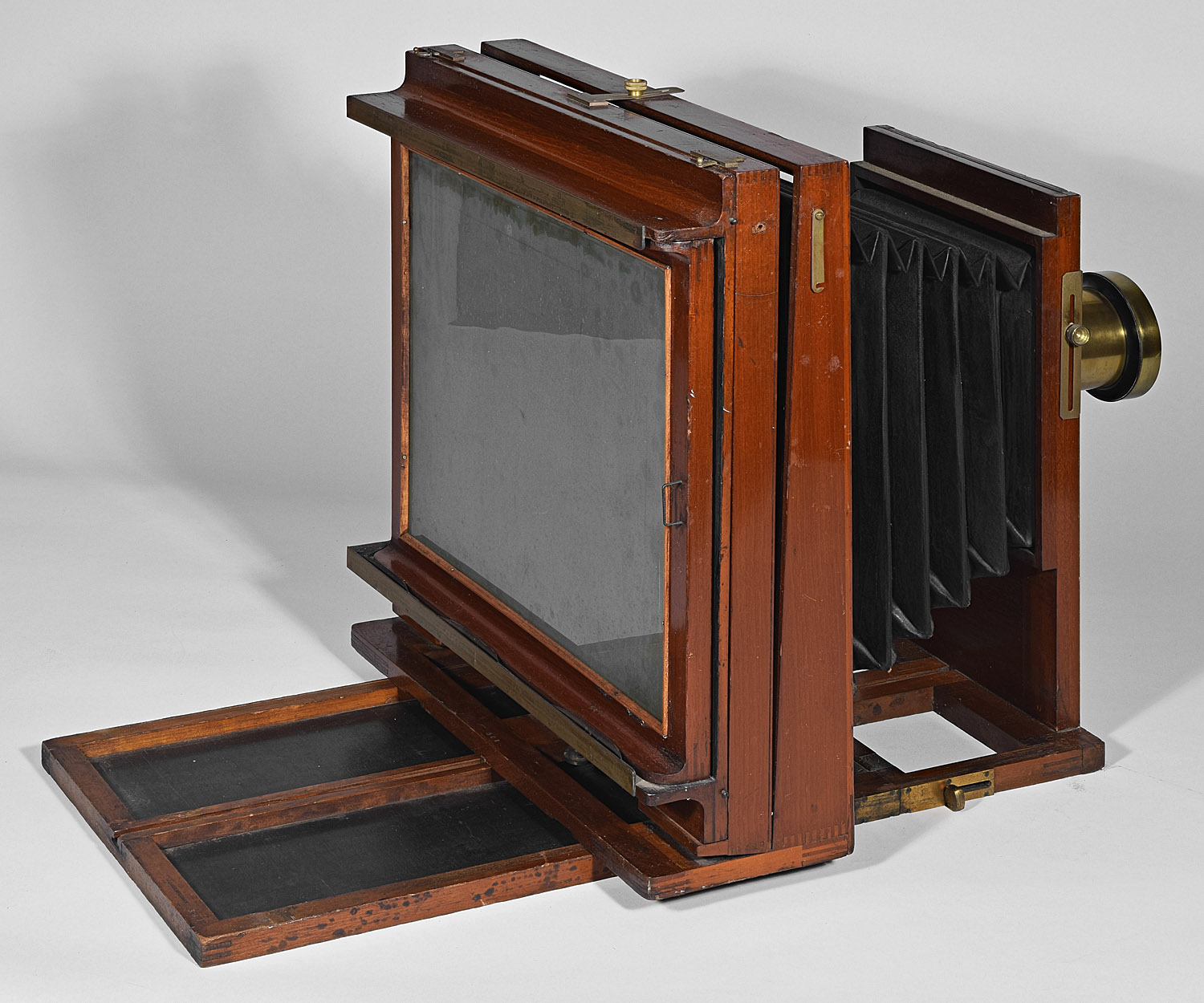
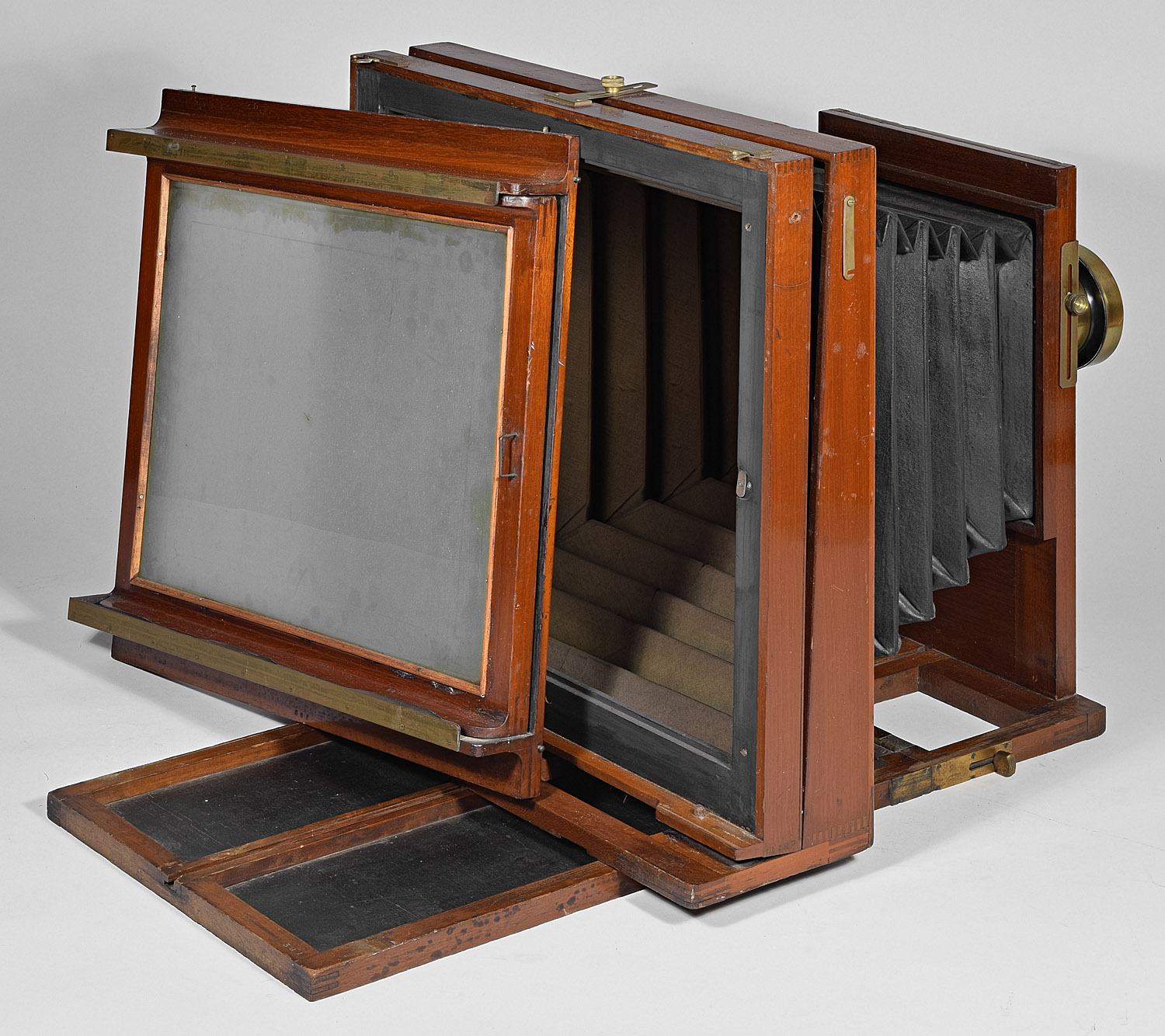
Bottom
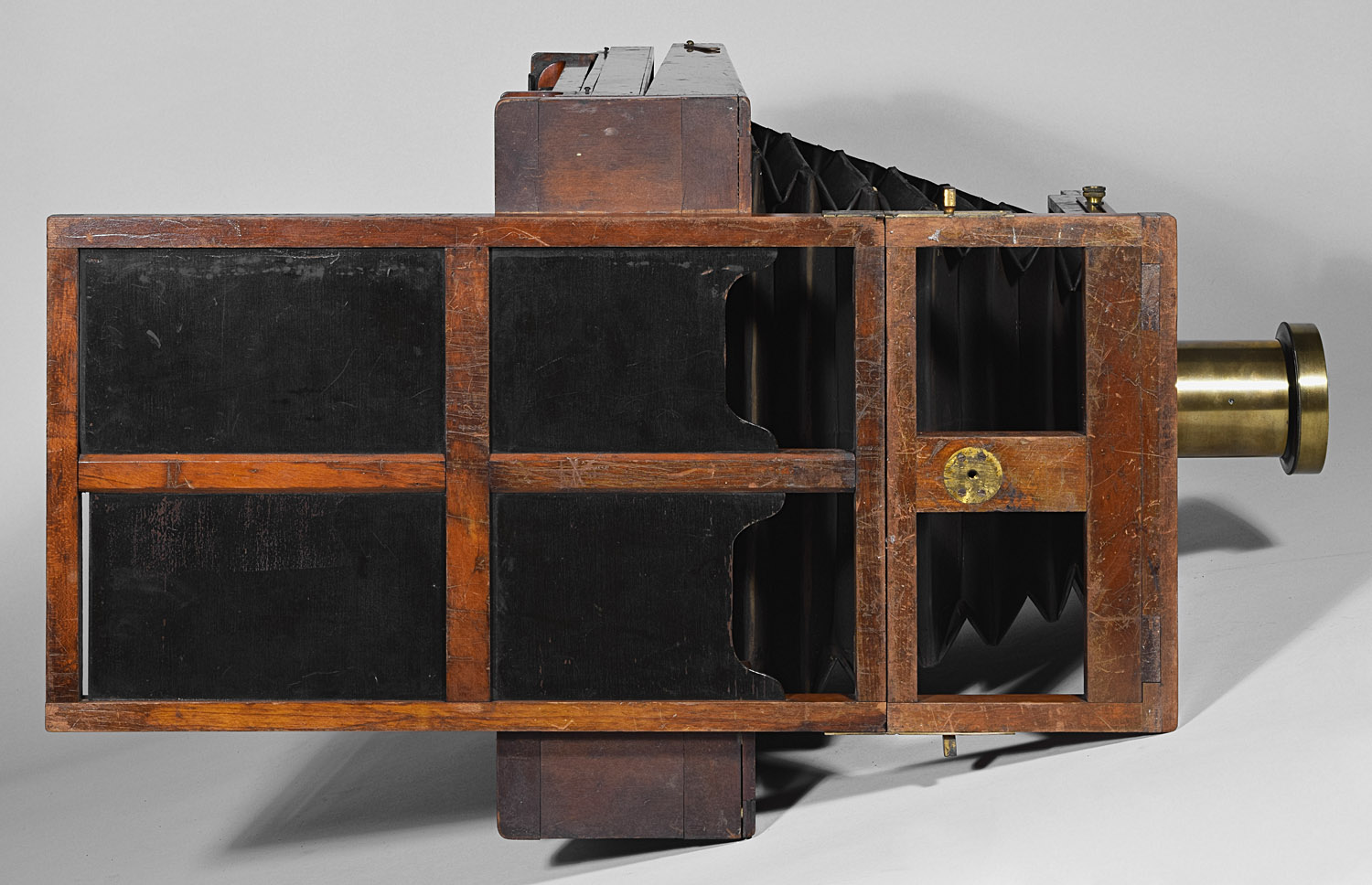
Top
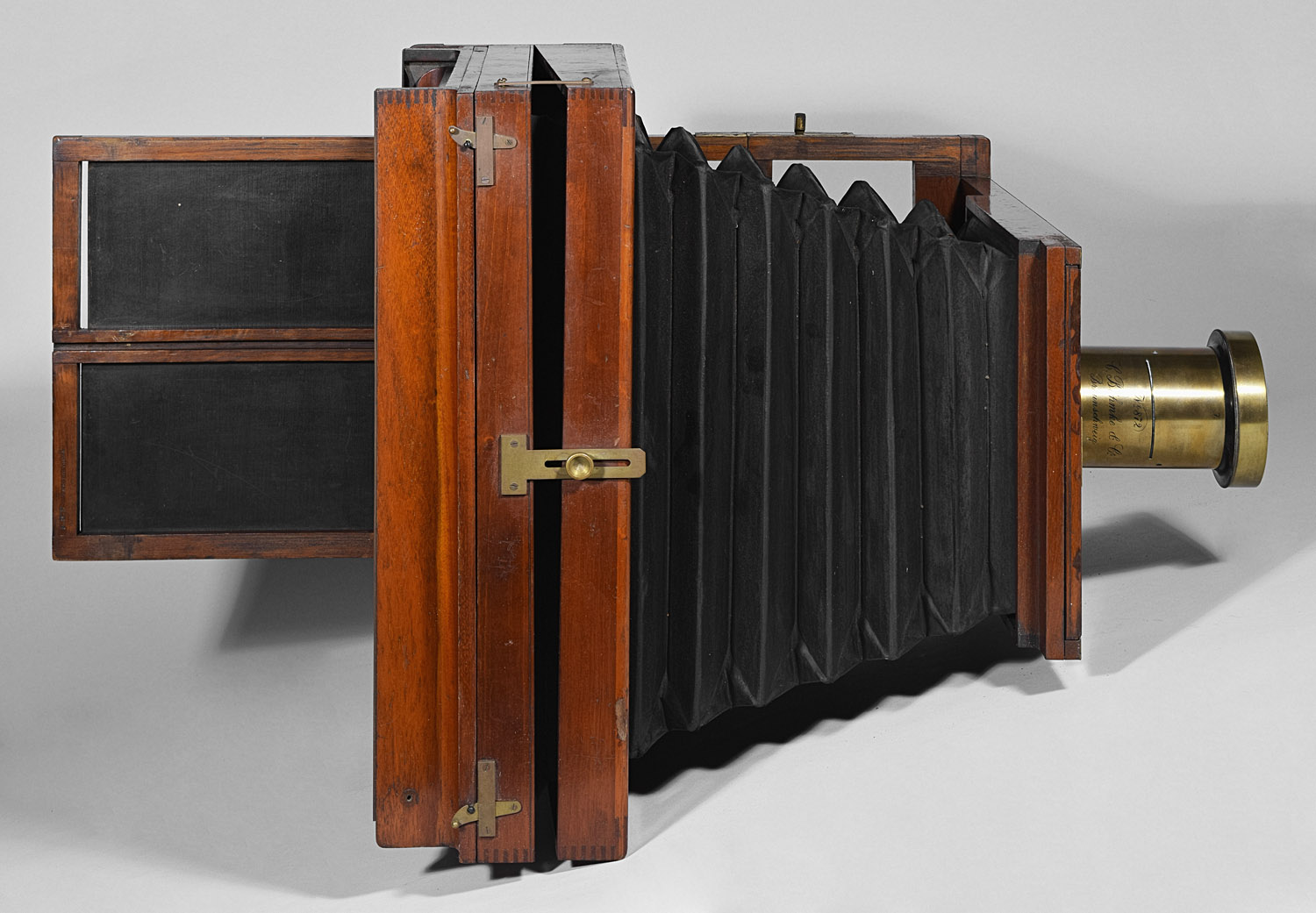


Date Introduced: - ; Years Manufactured:
c.1884 - c.1895
Construction: back focus
via push-pull; single or double swing; reversing by removable
back; French polish finish
Materials: mahogany body; cherry base;
black rubber bellows; brass hardware
Sizes Offered: 4¼x5½; 6½x8½; 8x10;
10x12; 11x14; 14x17; 17x20; 20x24
Notes:
Descriptive Catalogue and Price List of the Photographic Apparatus
Manufactured by the American Optical Co., Scovill Mfg. Co.,
proprietors and managers (New York, NY), Sept. 1884, p.52 (as the
Scovill Reversible Back Camera)
Catalog P, Photographic Material,
J. W. Queen & Co. (Philadelphia, PA), 1886, p.
72 (as the Reversible Back Cone View Camera)
Scovill Manf'g Co. Catalogue Photographic Goods, June, 1887, David
Tucker & Co. (Buffalo, NY), June, 1887, p.18
(as the American Optical Suberb Reversible Back Cone View Camera)
Scovill Manf'g Co. Catalogue Photographic Goods, June, 1887, David
Tucker & Co. (Buffalo, NY), June, 1887, p.44 (as the Scovill Acme
Reversible Back View Camera)
Catalogue Illustrated, W.D. Gatchel (Louisville, KY),
1888, p. 32 (as New Reversible Back Acme View Box)
Catalogue of Photographic Goods and All
Articles Pertaining to Photography, The Scovill & Adams Co. (New
York, NY), undated c.1895, p.14 (as the Scovill Acme Reversible Back
Camera)
